Somehow Lubeck, Germany’s most ravishing city, has always reminded me of Venice. An innocently cute and relatively small city that used to possess such political influence and economic power – reaching all over Europe and beyond.

Although Lubeck has incredibly beautiful buildings and alleys, seven church towers, three Nobel prize winners and world-famous marzipan, it does not suffer from destructive over-tourism. I don’t want to change that, however, I’d like to show you around one of Germany’s most ravishing cities.
Lubeck, Germany’s Most Ravishing City
“It’s the Venice of….” is an over-used reference as soon as a place has a creek and a gangplank. This is not the case with Lubeck – although the city center is an island between two rivers, and there are bridges alright.
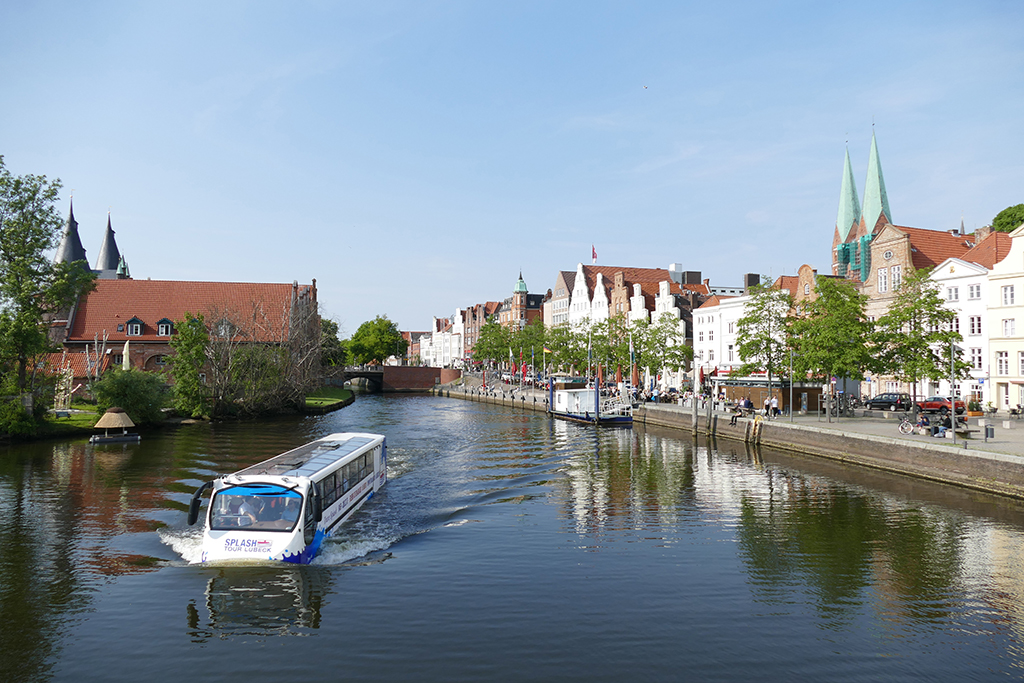
No, my reason for comparing Lubeck to Venice is based on the phenomenon that a relatively small city can possess such a political influence and economic power all over Europe and even across the seven seas.
Also, historically, this comparison is not that farfetched, as you’ll see below.
Lubeck was the Hanseatic League’s number one city. It has two city gates, was home to three Nobel prize winners and four martyrs. Lubeck was considered one of the five Glories of the Empire, there are six ancient salt warehouses, seven spires are designing the skyline….and counting.
The Rise
Lubeck’s everpresent beauty, its stately mansions, and monumental buildings are stemming from the former commercial power and immense wealth.
In 1159, merchant circles installed the Hanseatic League to maintain the guilds’ economic interests, diplomatic privileges, and protect the trade routes. It was the powerful Henry the Lion, Duke of Saxony, and Bavaria, who made Lubeck great. Little by little, the League grew along the coasts of Northern Europe.
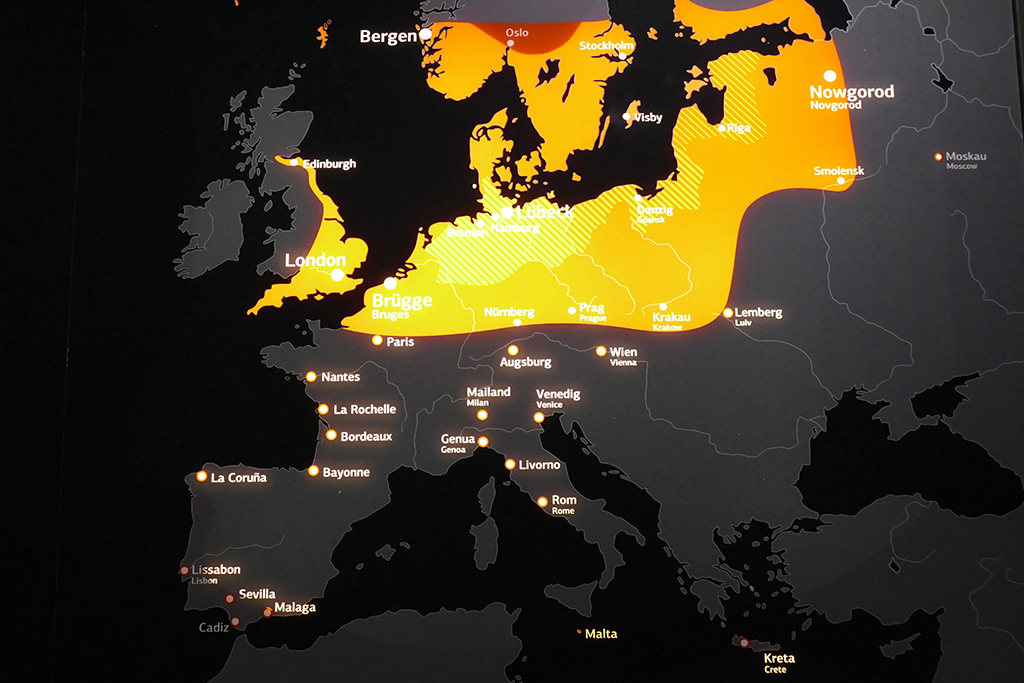
Lubeck is the Mother or the Queen of the Hanseatic League and was consequently the most important trading city in northern Europe during the Middle Ages.
Having access to the Baltic as well as to the north sea, Lubeck needed salt to preserve the catch and imported this white gold from the salt mines around Lüneburg, a town located south of the Hanseatic city of Hamburg. While today, the ride between Lüneburg and Lubeck takes about 90 minutes, in the 13th century, they had to travel the salt-trade route for weeks.
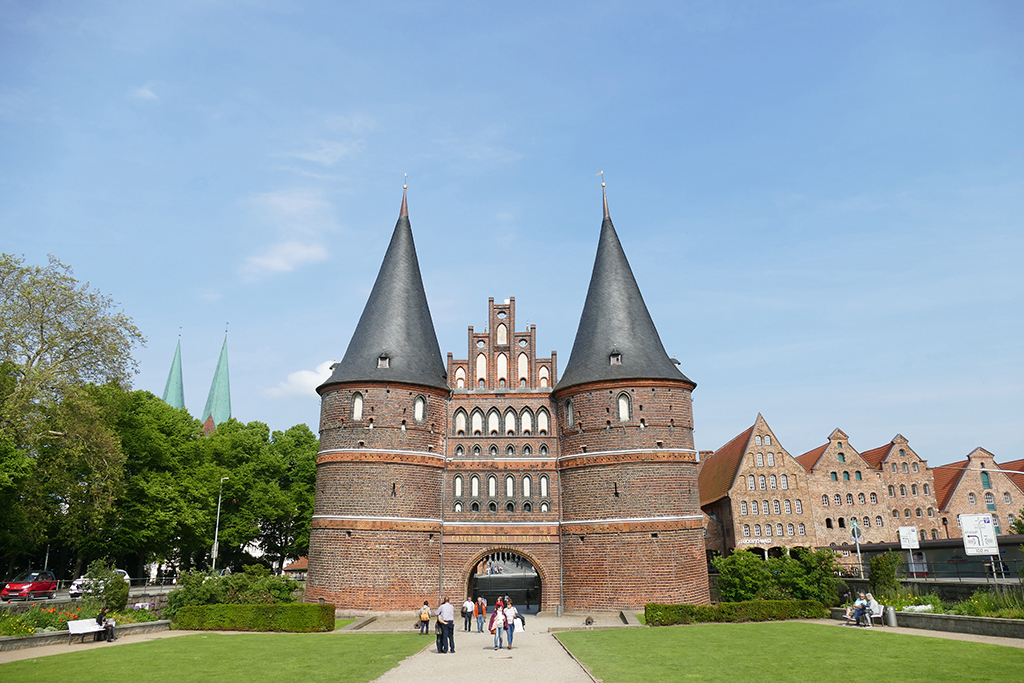
In the 14th century, Lubeck was the Holy Roman Empire’s third-largest city after Cologne and Magdeburg. It was Emperor Charles IV who named Lubeck one of the five Glories of the Empire in 1375, a title shared with Florence, Pisa, Rome, and….Venice!
The European Hansemuseum
The best way to learn in an informative yet very entertaining way about the heyday of the Hanseatic League is a visit to the fantastic European Hansemuseum on the city centers northernmost tip.
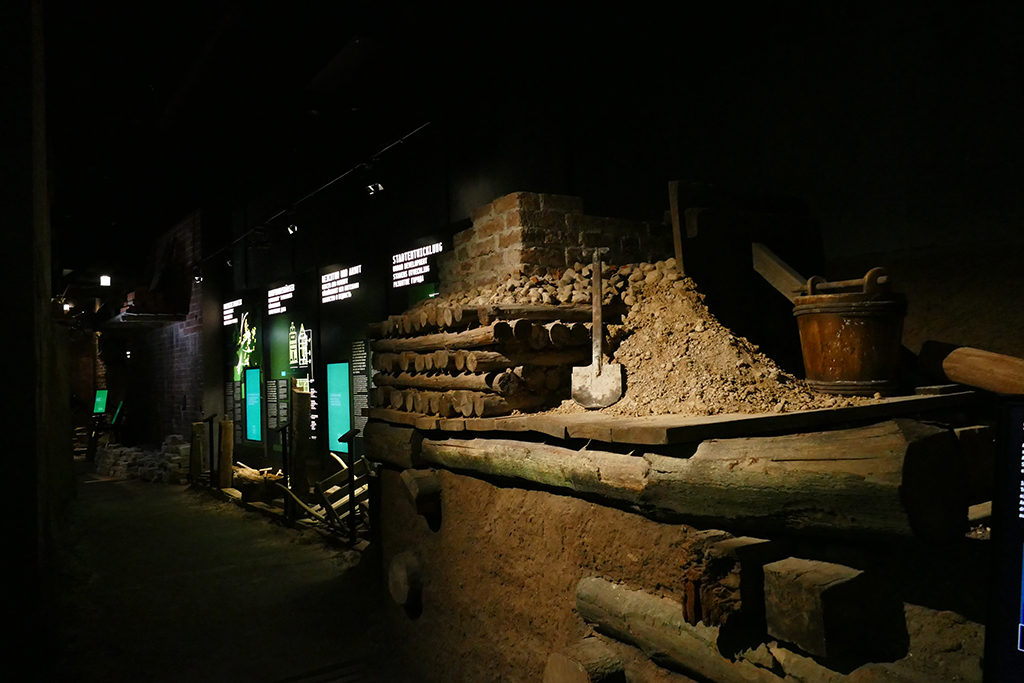
Opened in 2015, it informs on each and every related topic on more than 7000 square meters.
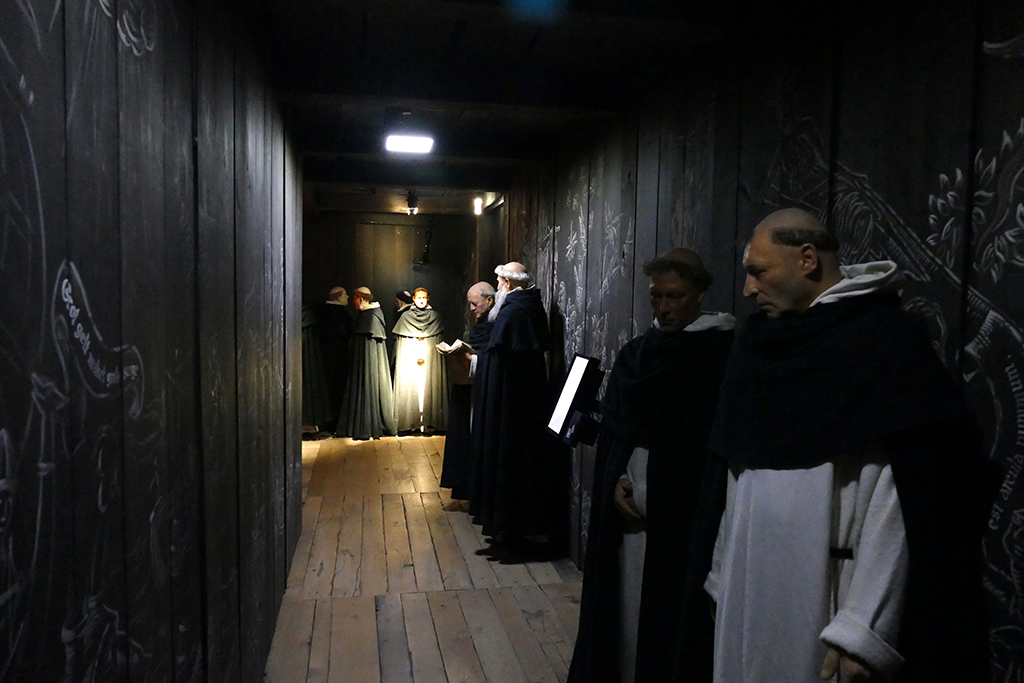
The fact that it is connected to the Burgkloster, a former Dominican Cloister from 1229 that can be also visited, even adds to the authentic charm. It makes you feel like travelling back in time.

Europäisches Hansemuseum
An der Untertrave 1
23552 Lubeck
Phone: +49 – 451 – 80 90 99 – 0
Email: info@hansemuseum.eu
The museum is open daily from 10 a. m. to 6 p. m. and only closed on December 24. Your museum ticket includes a visit to the Cloister.
Historic Old Town on an Island
The medieval city of Lubeck with its impressive number of cultural monuments has been part of the UNESCO World Heritage since 1987.
The World Heritage Site is located on the Altstadtinsel, the Old Town Island which forms a hill between the rivers Trave and Wakenitz. This island is only approximately the size of one square kilometer.
Nonetheless, there are amazing buildings, alluring cobblestone alleys, dreamy backyards…and much, much more.
Actually, the site consists of more than a thousand buildings, listed in the monument list.
However, the World Heritage Site is the entirety of the preserved part of the medieval city.

Nevertheless, some of the most important structures are also located outside the Old Town Island on the surrounding minor isles. For instance the Holstentor and the old salt warehouses which are standing on the so-called Wall peninsula.
The Dolls Bridge
Most visitors are entering the Old Town Island from the west, coming either from the train station, the bus station or from one of the big parking lots. It is not advisable to drive in the city center since many streets are really narrow and vast parts are pedestrian areas, anyway.
Getting into the center, you first cross the Puppenbrücke, the dolls bridge. The eight allegoric statues standing on the banister gave the bridge its name. The original sculptures, however, stand at the St.-Annen-Museum, I’ll get to that later.
The Holsten Gate
As soon as you cross the bridge, there it is, the iconic Holstentor, the Holsten gate, built in 1464. It is one of the two remaining gates of Lubeck’s medieval city fortifications. It is not only Lubeck’s signature building, but definitely one of Germany’s most famous structures. If you can’t make it to Lubeck: It also adorns the German 2 €uro coin.
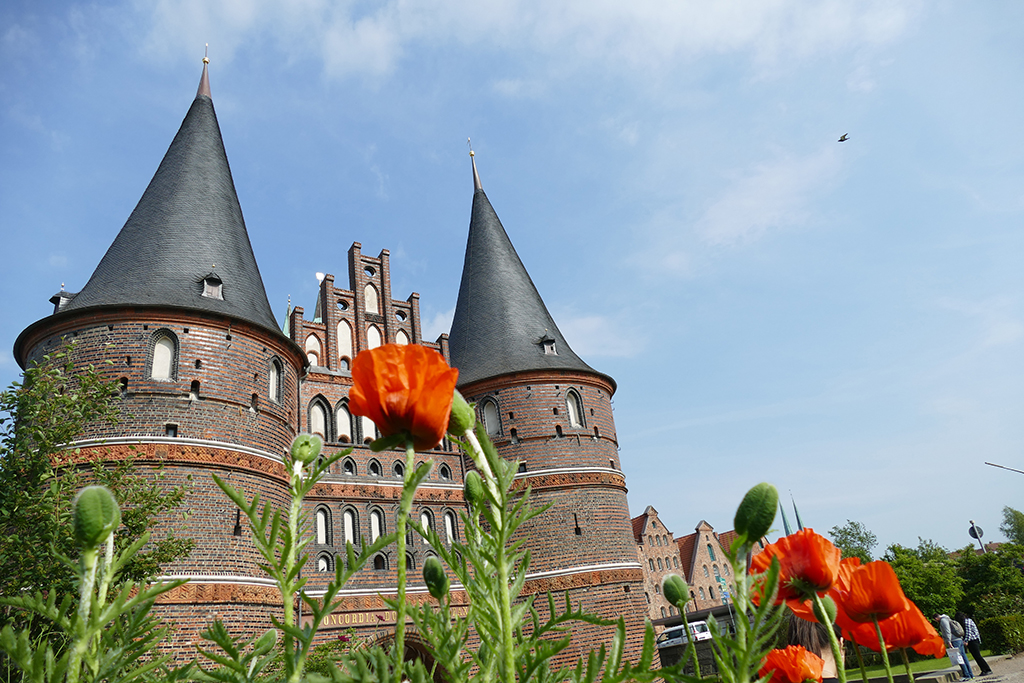
It stands all crooked since it was built close to the river Trave on boggy land. Over the centuries, a great effort was necessary to solve the problem for good.
Today it is one of Germany’s most photographed buildings and houses the city museum.
Museum Holstentor
Holstentorplatz
23552 Lubeck
Phone: +49 – 451 – 122 41 29
Opening hours are from January to March from Tuesday to Sunday
from 11a. m. to 5 p. m. and
from April to December daily from 10 a. m. to 6 p. m.
Before you walk across the park towards the Holstentor, you might want to pay the tourist information a visit, it is just south of the park and a great spot for planning and preparing your further visit: They, obviously, have lots of info, but also a café where you can plan your day enjoying some local refreshments.
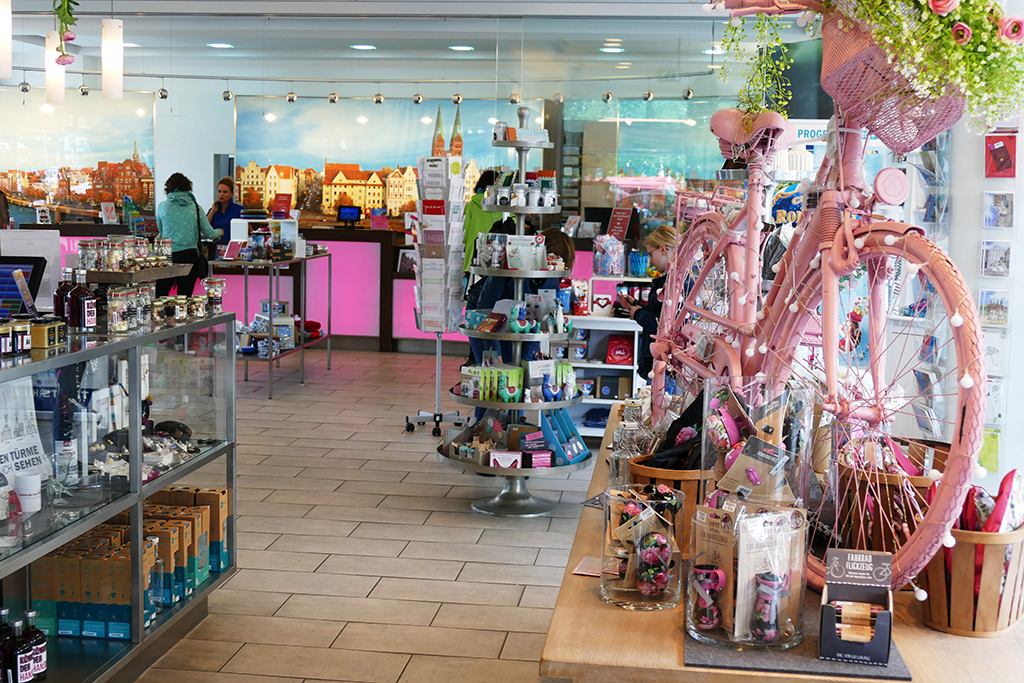
Medieval Times
To get the best overview of Lubeck, you either have to reach high or bend low.
Coming from the gate, you’ll spot the tower of St. Peter’s church to your right. It is one of Lubeck’s five main churches, however, today, only special services are taking place. Otherwise, the church is used for contemporary exhibitions of artists like Kiki Smith, Guenther Uecker, Thomas Zipp, or Arnulf Rainer who designed the altar cross.
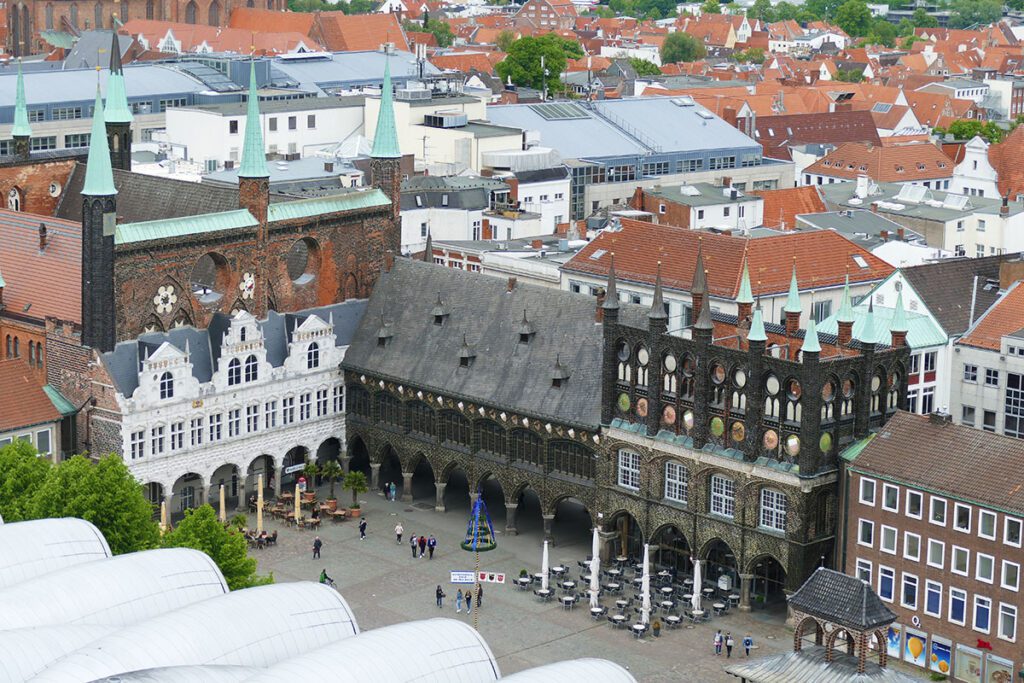
For only 4 €uro, an elevator takes you 50 meters up the 108-meter high tower from where you can see all of Lubeck.
Since the church’s opening hours vary, check out their website before going.
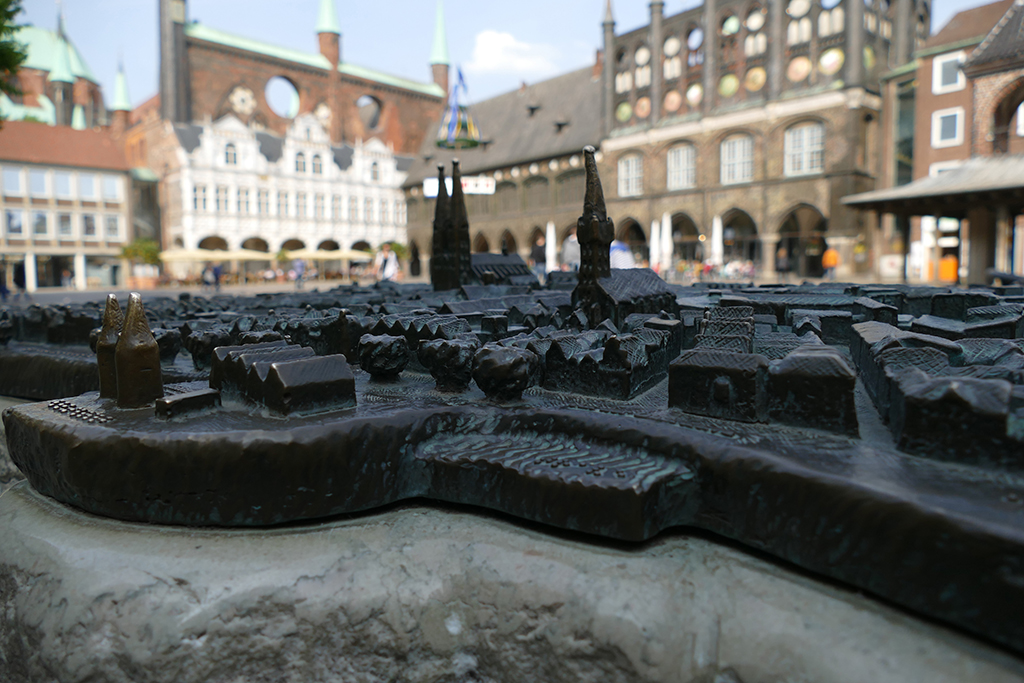
A less windy alternative is the city model at the southwest corner of the old market square. The local Rotary club donated this miniature so that impaired and blind people can enjoy Lubeck’s beauty, too.
And while you are on the square, take a look at the Medieval townhall, undoubtedly one of Germany’s most beautiful governmental buildings.
Three in One
You might wonder, which one of these buildings it is? Well, all of them. The town hall was built in many stages – and therefore in various styles. There is the late Romanesque part from the early 13th century with the noticeable holes. They were left for the strong breeze going through and not damaging the walls.
Adjacent is the black, Gothic part from the late 13th century and finally the white part in a tender Renaissance style from the 16th century.
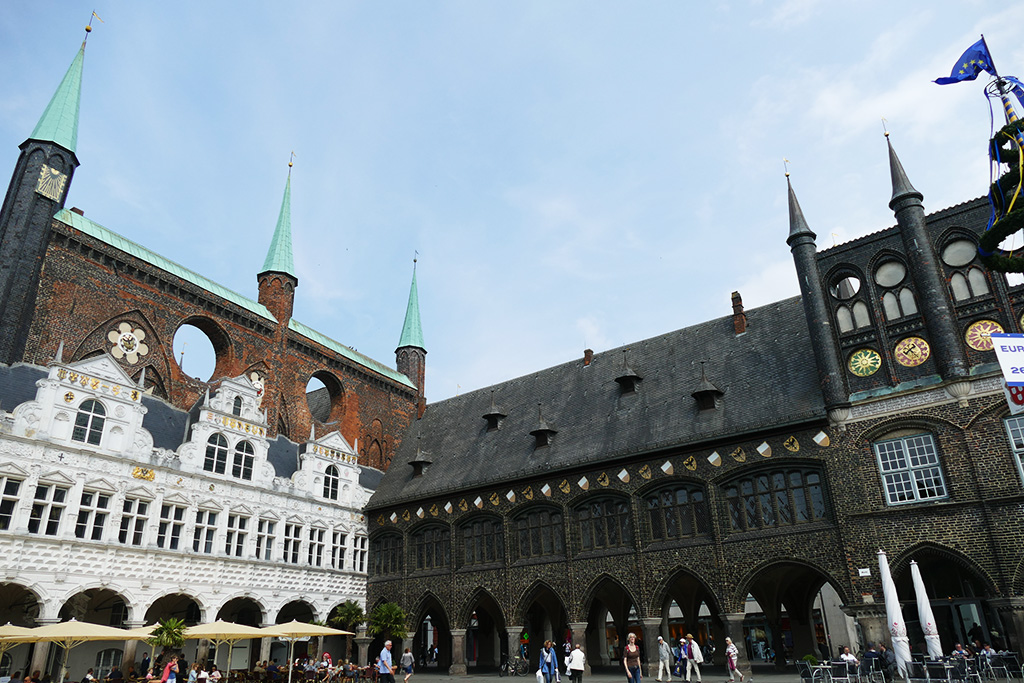
You can visit the inside either on a guided tour organized by the tourist info or on a tour by the town hall.
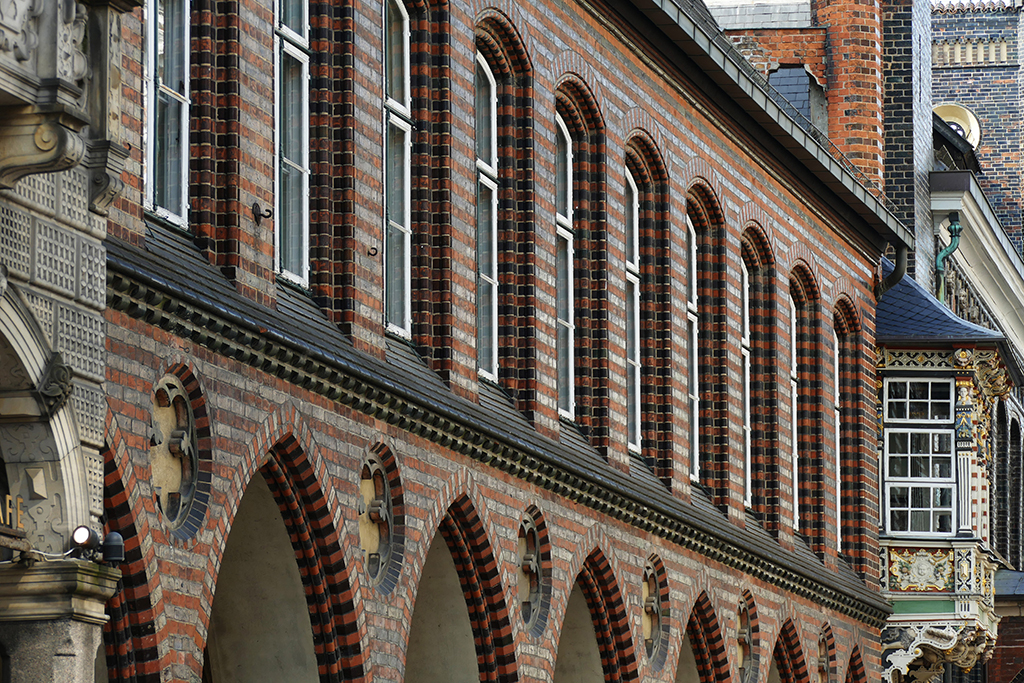
Lubecker Rathaus / City hall of Lubeck
Breiten Straße 62
23552 Lubeck
Phone: +49 – 451 – 12 20
Guided tours are from Monday to Friday at 11 a. m., noon, and 3 p. m and weekends at noon. A tour is also included in a walking tour organized by the Tourist Information.
St. Mary’s
Right next to the town hall is another Medieval building you should not miss, the St. Mary’s church, one of the most important buildings built in the iconic red-brick Gothic style. I’ll get to St. Mary’s further below.
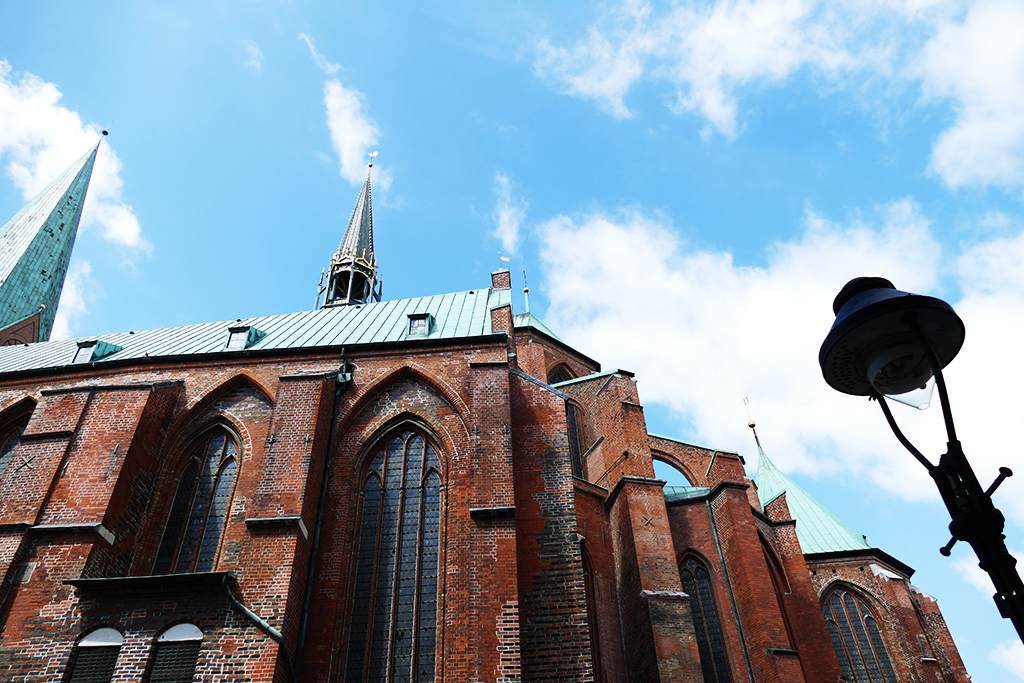
Since the Middle Ages, the wealthy burghers of Lubeck shared and endowed – not because they were such good people….or at least it wasn’t the only reason. Most of all they were keen on getting freedom of soul and a prime spot in the afterlife.

Hospice of the Holy Ghost
The Heiligen-Geist-Hospital, the Hospice of the Holy Ghost, is probably the finest and also oldest example of the charitable foundations in Lubeck.
The hospice, built in 1286, granted room for sick, old, and poor people who had to live according to cloister-ish rules. They received mainly food and from the 17th century on also a bath – eight times a year.
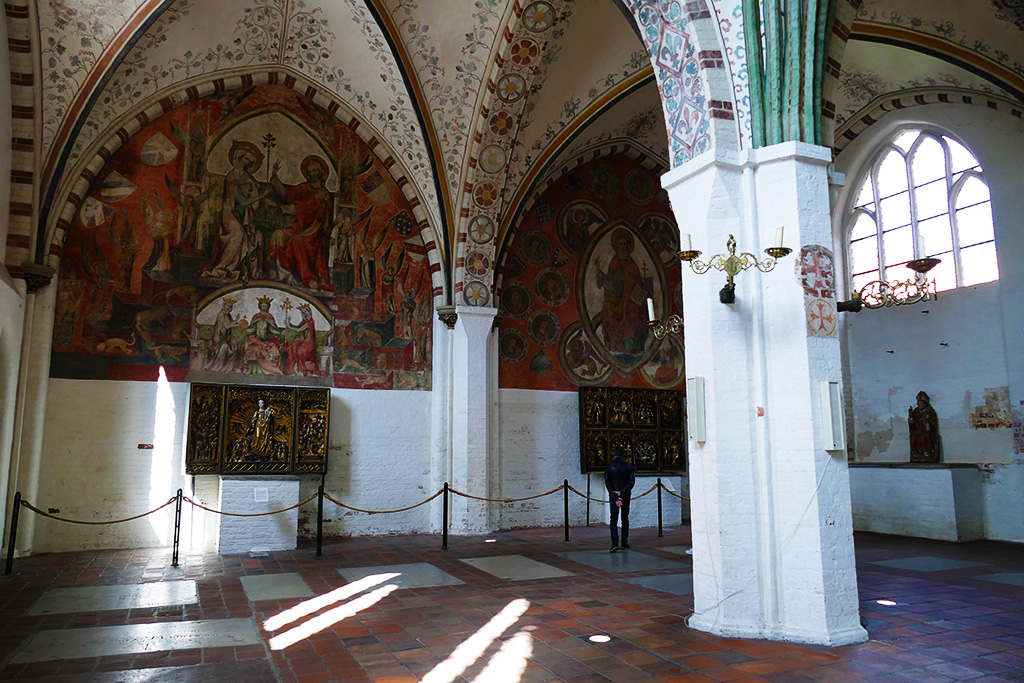
During Reformation, the hospice became a rather worldly old people’s home – which actually lasted till the 1970s.
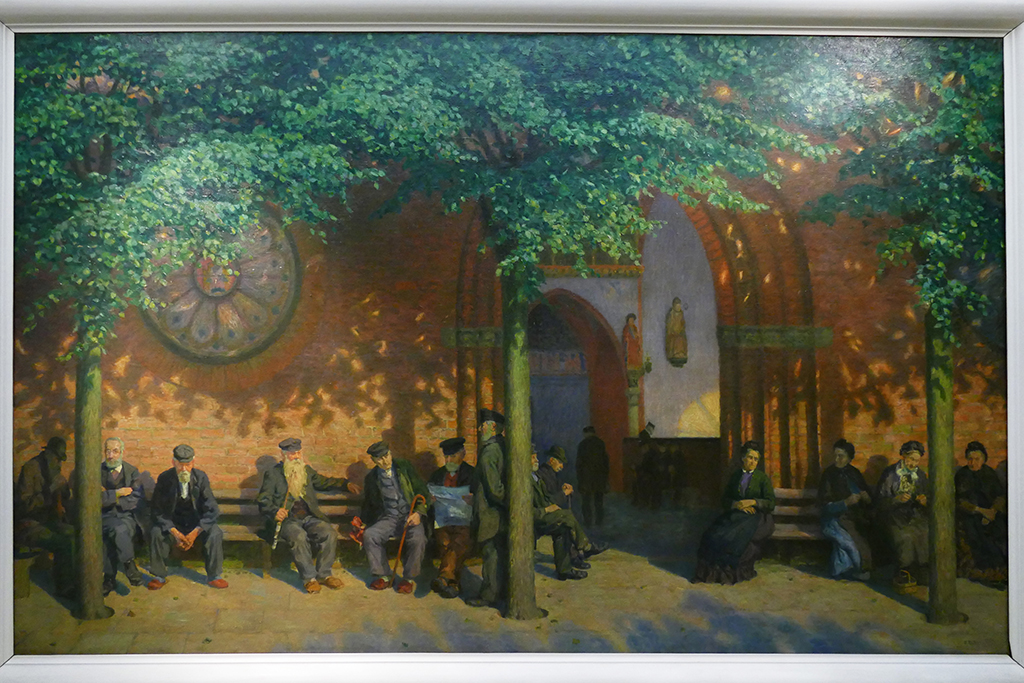
Today, the Heiligen-Geist-Hospital is one of Lubeck’s most popular landmarks. The Christmas market that takes place every year is definitely one of the nicest ones. People are actually waiting patiently in line at the door since space is limited and the products on sale absolutely original and of very high quality.
Heiligen-Geist-Hospital
Koberg 11
23552 Lubeck
The Hospice is open daily from Tuesday to Sunday from 10 a. m. to 5 p. m.
A Joint for the Wealthy
Across from the hospice on the other side of the Koberg square is – next to mostly classicist buildings – the assembly hall of the traditional Schiffergesellschaft, the fine mariners’ association, founded by wealthy tradesmen in 1401 firstly as the Saint Nicolas Guild.
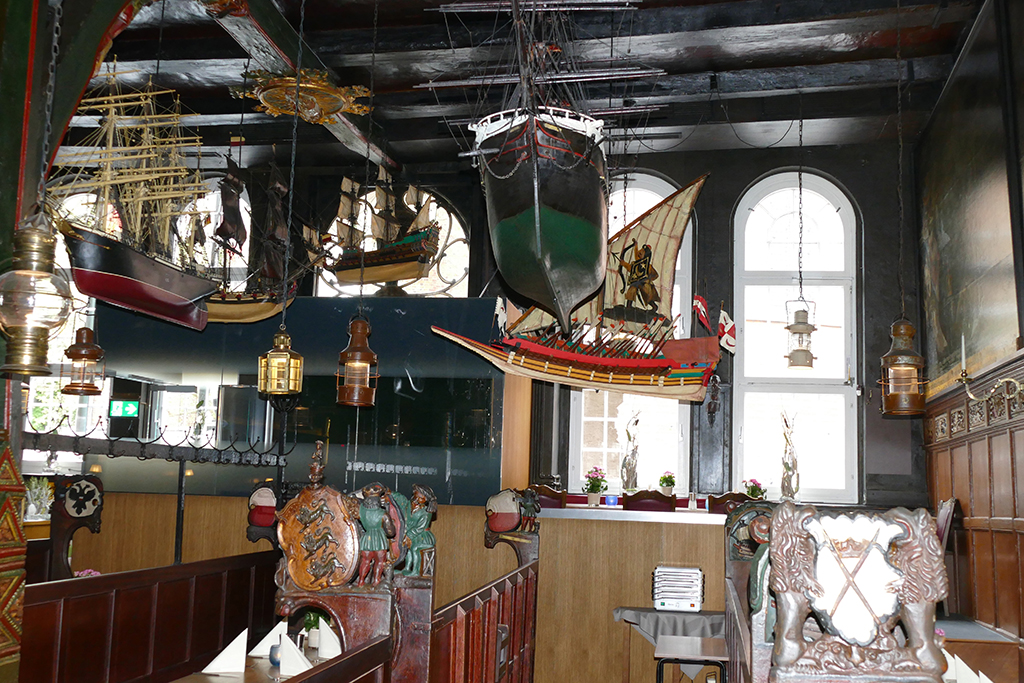
The guild bought the house built in red brick renaissance style in 1535 and made it their assembly hall.
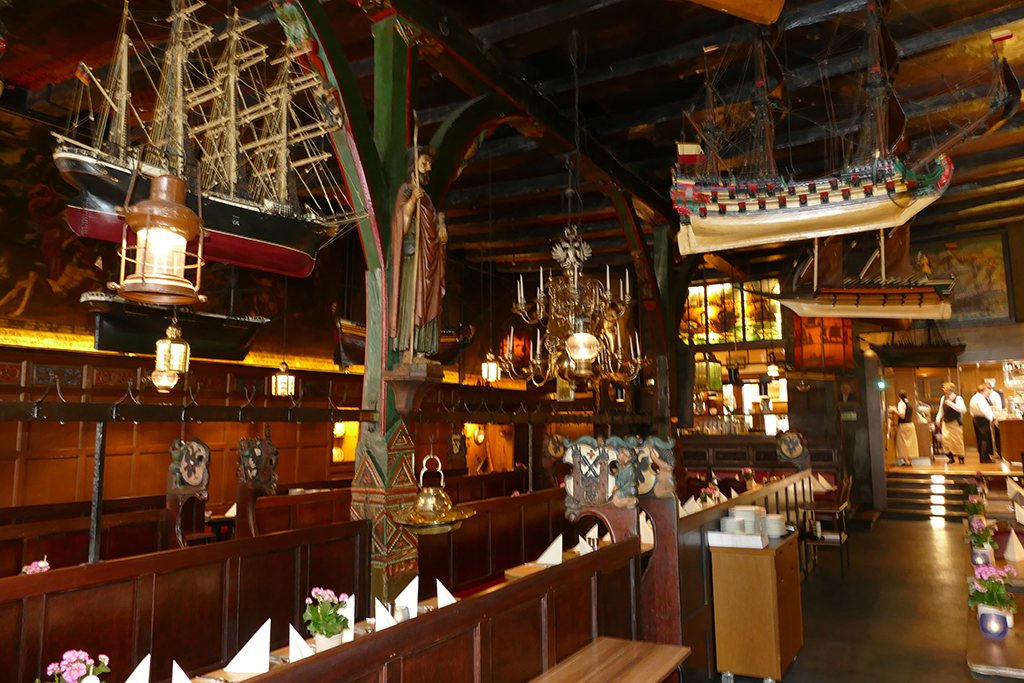
Today, the Schiffergesellschaft is not only one of Lubeck’s most famous landmarks, but also an exquisite restaurant. No visit to Lubeck is complete without a meal at one of the old dark wooden tables.
Restaurant Schiffergesellschaft
Breite Straße 2
23552 Lubeck
Phone: + 49 – 451 – 767 76
Email: restaurant@schiffergesellschaft.de
The Schiffergesellschaft is open daily from 11 a. m. to 11 p. m.
After a generous meal at the Schiffergesellschaft, you might feel like walking a bit, and crossing the old town southwards will get you to one of the most amazing museums Lubeck has to offer.
St.-Annen-Museum
The St.-Annen-Museum was opened in 1915 in the structures of a former cloister, built from 1502 to 1515 in a late Gothic style. The inhabitants were mainly unmarried daughters of Lubeck’s burghers – aka old spinsters. With the undergoing Reformation, the last nuns left the cloister in 1542. Eventually, the building became an almshouse and a prison – at the same time and under the same roof and the same management.
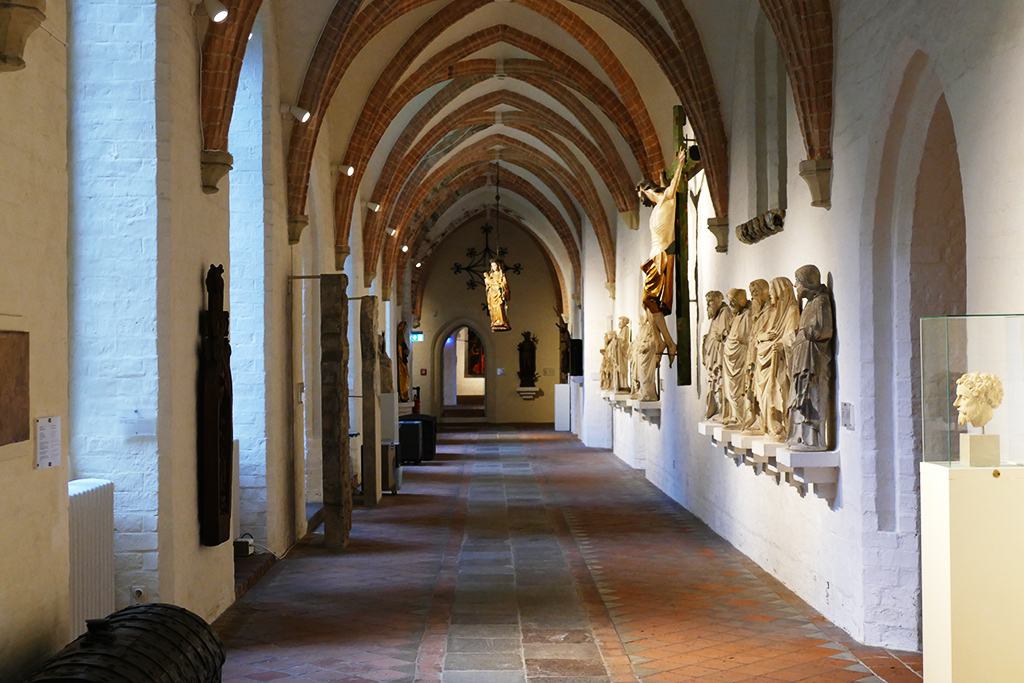
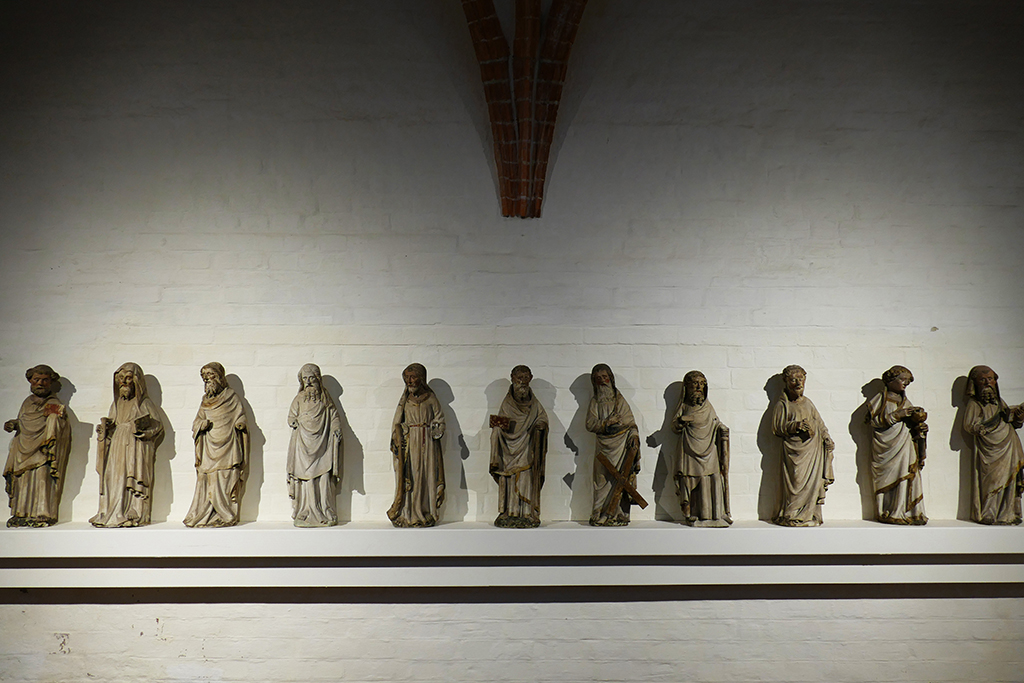
Today, major parts of the building are still the original structures.
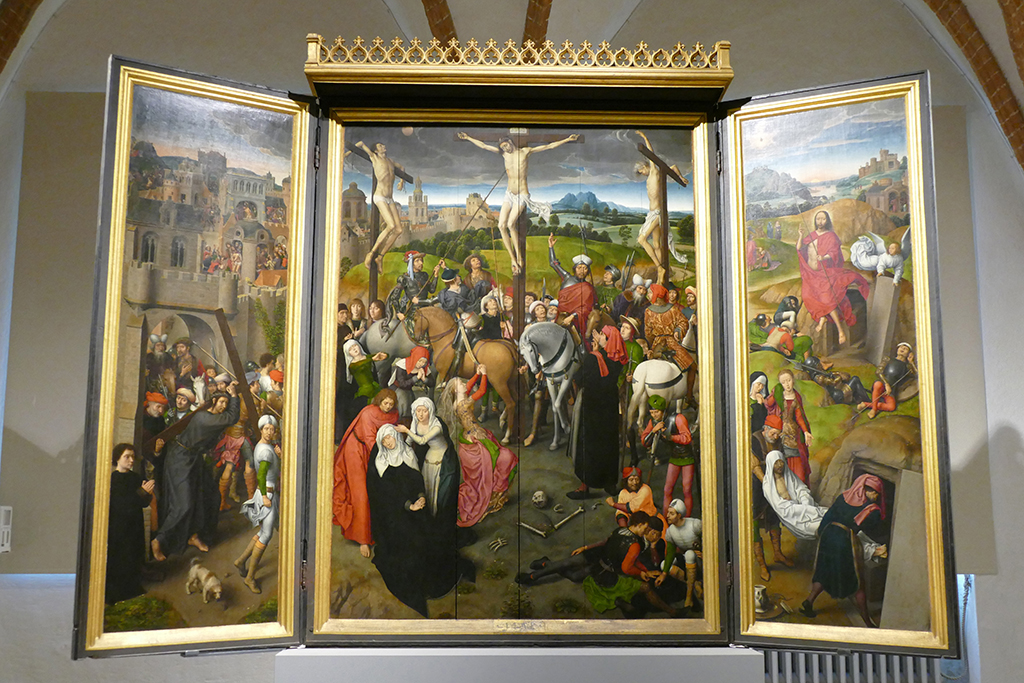
The museum houses an impressive collection of sacral art like winged alter pieces and statues, but also fine examples of traditional local home decor and even an entire pharmacy.

The new annex offers space for contemporary art; and, finally, in the courtyard are the original statues from the Puppenbrücke.
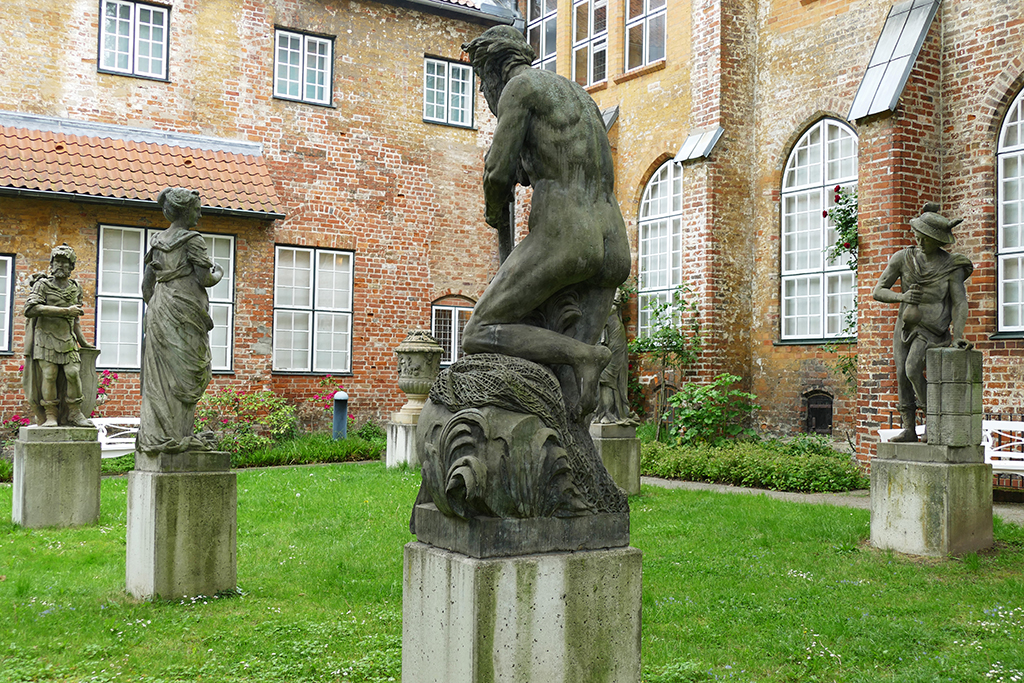
The St.-Annen-Museum is on very few tourists’ lists – which is a big mistake.
St. Annen-Museum
St. Annen-Straße 15
23552 Lubeck
Phone: +49 – 451 – 122 41 37
Opening hours are from January to March from Tuesday to Sunday from 11a. m. to 5 p. m. and
from April to December already from 10 a. m.
Seven Spires
Queen of the Hanseatic League, the Holstentor, the city hall, the hospice….there are just so many titles and iconic landmarks in small Lubeck. I still haven’t introduced one of the most important ones: Lubeck is also called the city of the seven spires.
These seven towers belong to the five Gothic main churches, St. Jakobi, St. Marien, St. Petri, St. Aegidien and the Lubeck Cathedral, going from north to south:
St. Jakobi
St. Jakobi – or Saint James’ Church – is between the Hospice of the Holy Spirit and the Schiffergesellschaft next to the Koberg square. It was consecrated in 1334 as a church of sailors and fishermen. This church, the Holy Spirit Hospice, and the neighboring Gertrudenherberge, a medieval pilgrims’ hostel, are stops on a branch of the North German Way of St. James.

The church’s clock tower is an interesting feature since it displays only hours as a one-hand watch. This February, however, the pointer of the northern clock-face fell off and crashed down 50 meters on the church forecourt.
St. Marien
Built between 1250 and 1350, St. Marien – respectively Saint Mary’s Church – has always been a symbol of the power and prosperity – and pomp – of the Hanseatic city.
St. Mary’s is the epitome of the classic North German Brick Gothic and set the standard for about 70 other churches in the Baltic region.
Besides the impressive structure, there are some quirky stories and superstitions about the building.
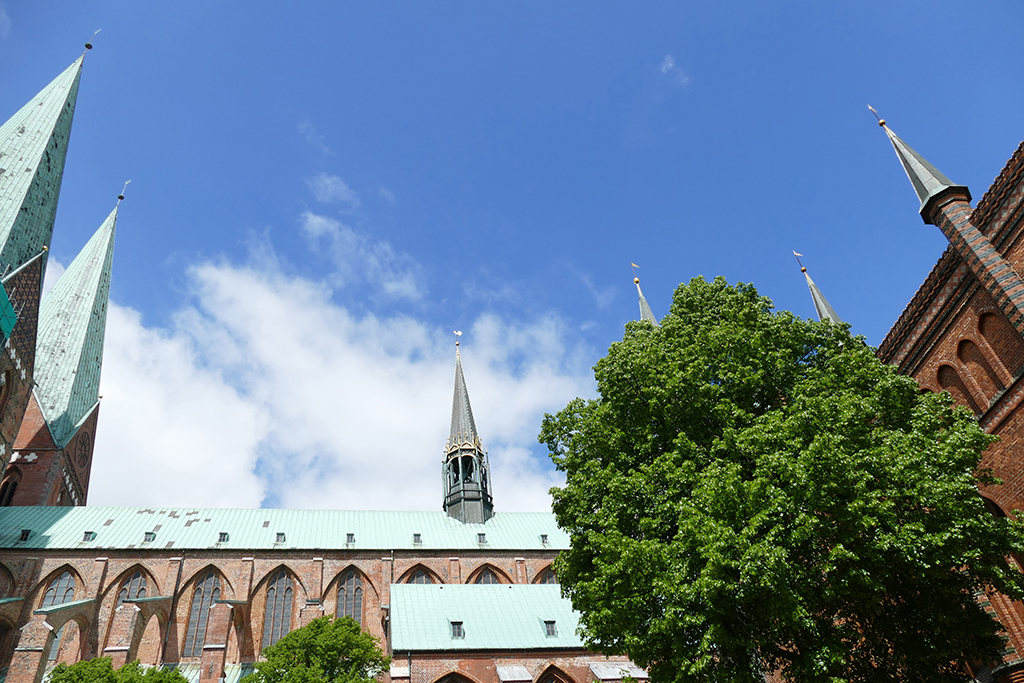
Rosemarie
The first one is about the mouse Rosemarie: Once upon a time, there was a rose tree, which grew for a long time on the side of the St. Mary’s Church. It was believed that Lubeck would be free as long as the bush was green and blooming. For many years and decades, they enjoyed the rose, until one day it began to wither. As the inhabitants laid the roots of the bush free, they saw that mouse Rosemarie had planted a nest between the roots and her babies eagerly nibbled the roots.
It happened the way it had to: Lubeck was forced to surrender to the Danes.
However, in 1227, northern German princes and cities finally defeated the Danish king Waldemar II., and the Hanseatic city was free again and Lubeck became even more powerful.

Therefore, the mouse Rosemarie was immortalized in a sandstone relief in St. Mary’s Church.
It is believed that touching her with your left hand will bring you happiness.
Don’t tell anyone, but she sits in the lower-left corner of the sandstone relief behind the altar.
The Devil Does Care
On a bench in front of the church, you’ll spot a little – quite friendly looking – devil. He refers to the story that the Lubecker’s told the devil they would build a tavern and not a church. The delighted devil helped with the construction. Only shortly before the completion, he discovered the deception and wanted to destroy the church with a huge stone. Since the Lubecker’s assured him thereupon the construction of a nearby tavern, today’s Ratskeller, the devil dropped the stone close to the church where the little statue. Created by Rolf Goerler, it is sitting there to this date. Touching the horns is supposedly bringing luck.
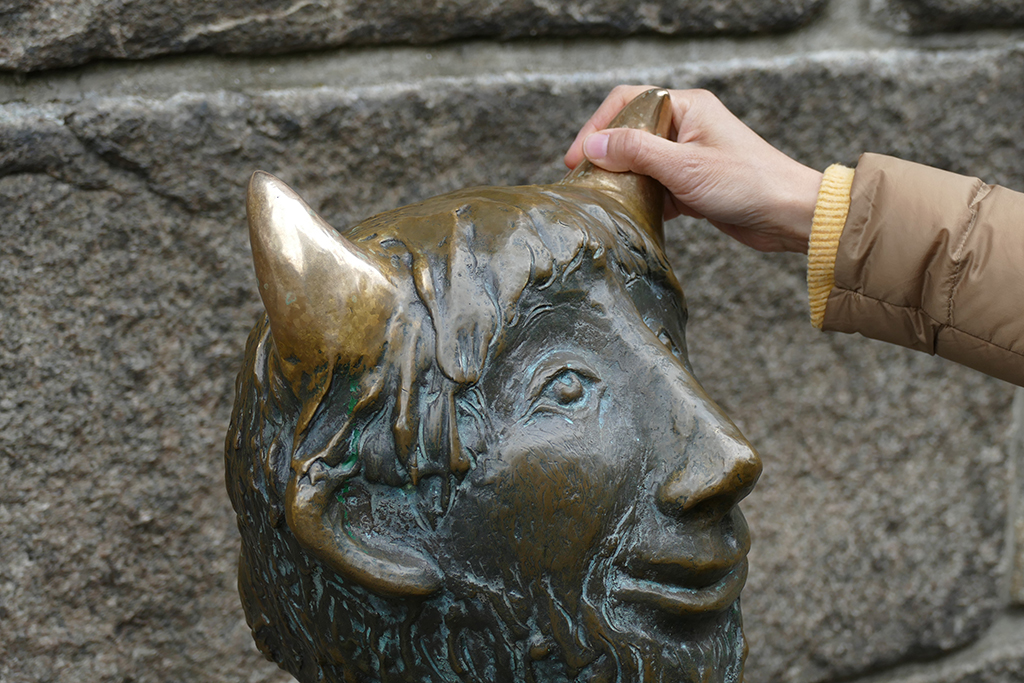
My favorite, however, is the Lübecker Totentanz, the dance macabre of Lubeck, that you’ll find in many spots of the church. It was created in 1463, probably under the impression of the plague, the so-called black death. Death, embodied skeletons, is dancing a roundelay with nobles, clerics, and simple folks, good and bad, in a memento mori – being everyone’s faith.

Sadly, there is also another reminder of death and loss. During the destructive air raid in 1942, also this church was severely damaged. As an anti-war symbol, they left the remnants of the bell as it fell on the floor of the southern tower.
Petrikirche
Saint Peter’s Church was first mentioned – together with the Marienkirche – in 1170. Between 1227 and 1250, the three-nave church hall was constructed in a late Romanesque style. However, after several alternations and extensions, the church was finally completed in the 15th century.

During WWII, the church was severely damaged and eventually fully restored in 1987.
Unfortunately, since the equipment could not be restored, only special church services take place, and the Petrikirche is mainly used for cultural and religious events as well as art exhibitions.

Nonetheless, it is probably one of the most visited churches in Lubeck since from the platform, you have a fantastic city view.
St. Aegidienkirche
Saint Aegidien Church is the smallest, least famous, and easternmost of Lubeck’s iconic inner-city churches. Although it was first mentioned only in 1227, the original construction of a wooden church probably stems from the years between 1172 and 1182.

This church was located at the center of a rather impoverished artisan quarter on the eastern slope of the inner city towards the river Wakenitz. The remaining buildings of the convent, the Aegidienhof, are one of Schleswig-Holstein’s largest housing projects, and the St. Annen Monastery is now a museum – see above. Together they form the Aegidien district of Lubeck’s old town.
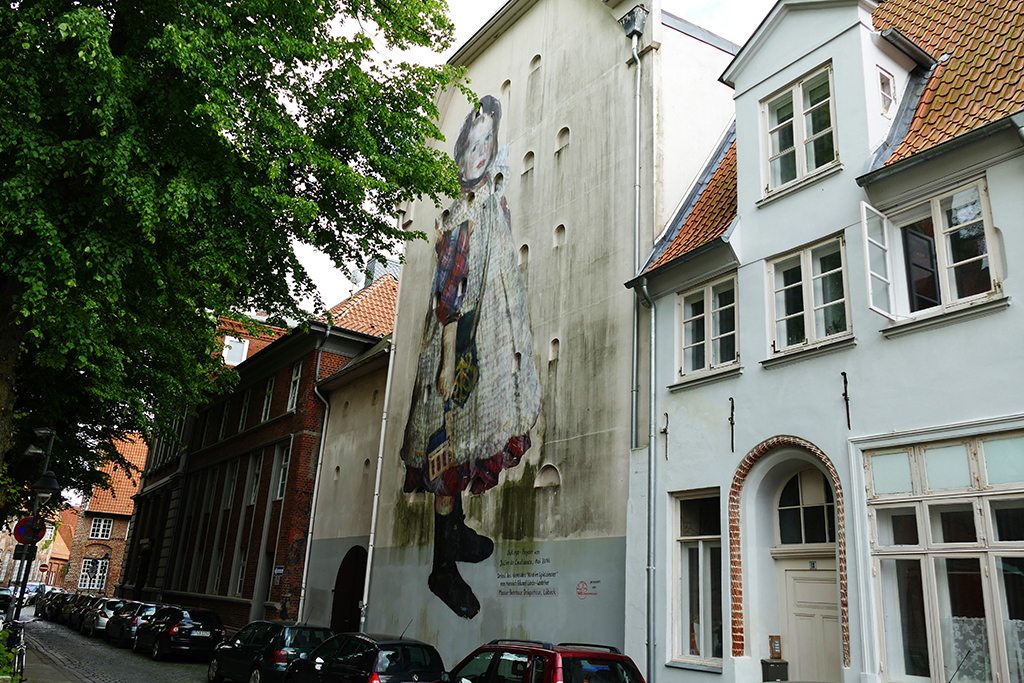
Dom
The Lubeck Cathedral was the first brick church on the Baltic Sea and, with a length of around 130 meters, one of the longest ones. It was consecrated in 1247.
Severely damaged during the air raid in 1942, its reconstruction took several decades as the reconstruction of the Marienkirche was a priority.

Finally, the Cathedral’s reconstruction was only completed in 1982.
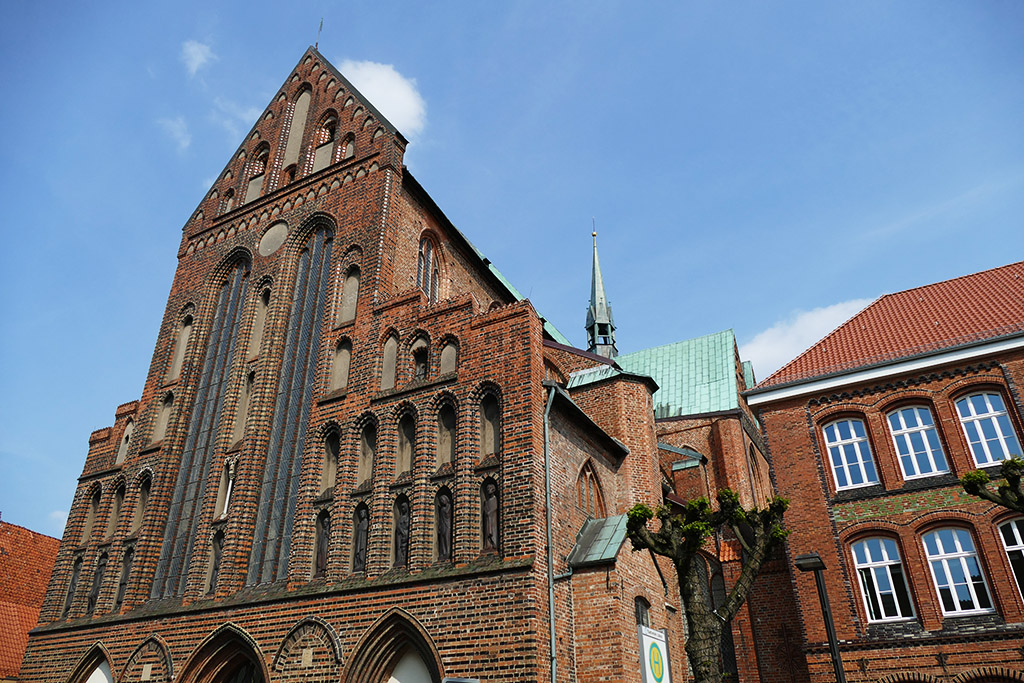
The density of so many, so similar churches in such a relatively small area – they are minutes one from another – is quite amazing, especially in a traditionally protestant region.
From Classicism to Art Nouveau

Behnhaus and Drägerhaus
Although over the centuries, Lubeck had lost its political influence, the city eagerly maintained its economic power. Many beautiful facades in classicist style still prove it.
Some of the former bourgeois villas are housing exquisite museums.
The most extensive collection is at the ensemble of the Behnhaus and Drägerhaus.
The Behnhaus was built in 1783 and thoroughly decorated by Danish architect Joseph Christian Lillie at the beginning of the 19th century. In 1823, the physician Georg Heinrich Behn bought the house that remained family-owned till 1920.
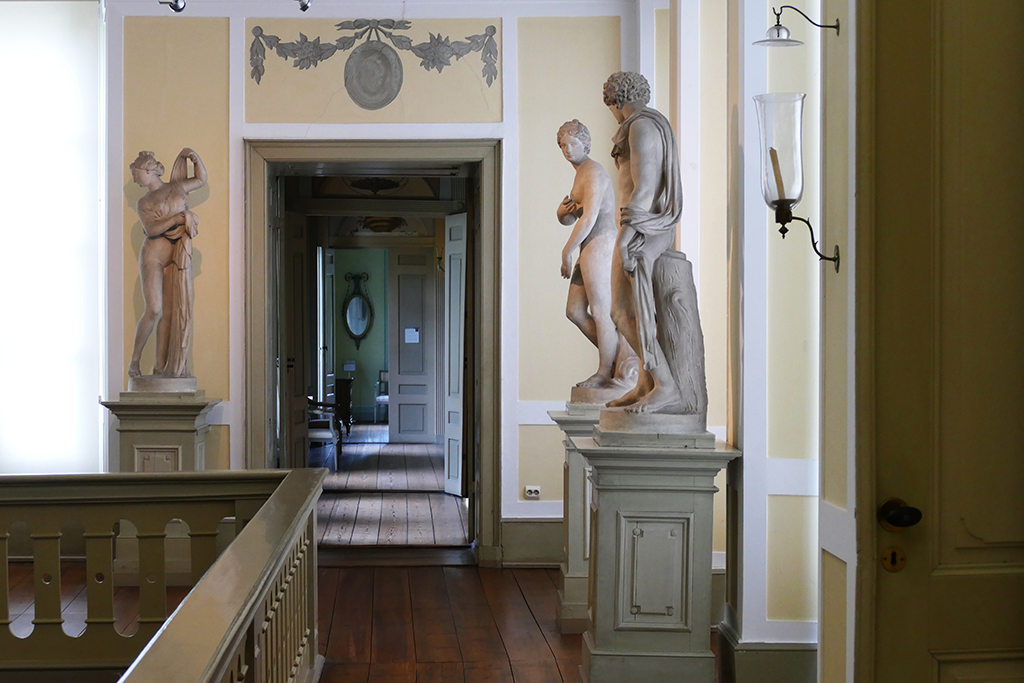
Eventually, it became an art museum.
The neighboring building was renovated with funds from the Dräger-Foundation and transferred to the city of Lubeck.
In 1981, the Behnhaus and the Drägerhaus were connected. Now they are housing a gallery of paintings from the 19th century and classic modern art like i. a. the art collection of another bourgeois citizen, Dr. Max Linde.

Ophthalmologist and art collector Dr. Max Linde was particularly involved in the art history of the 20th century as a patron of Edvard Munch. Munch also painted his four sons.

Nonetheless, also the rich bourgeois home decor from the Rococo, Classicism and Biedermeier eras are absolutely beautiful.

Museum Behnhaus Drägerhaus
Königstr. 9-11
23552 Lubeck
Tel.: 0451-122-4148
Willy Brandt Haus
Relatively late, in 2007, an exhibition on one of Germany’s – also internationally – most popular politician opened its gates. Lubeck-born Willy Brandt, the great German Social Democrat who migrated from the Nazis to Norway and after WWII became a journalist and politician.
He was among others the mayor of Berlin, Germany’s foreign minister and eventually, chancellor and for 23 years the Leader of the Social Democratic Party.
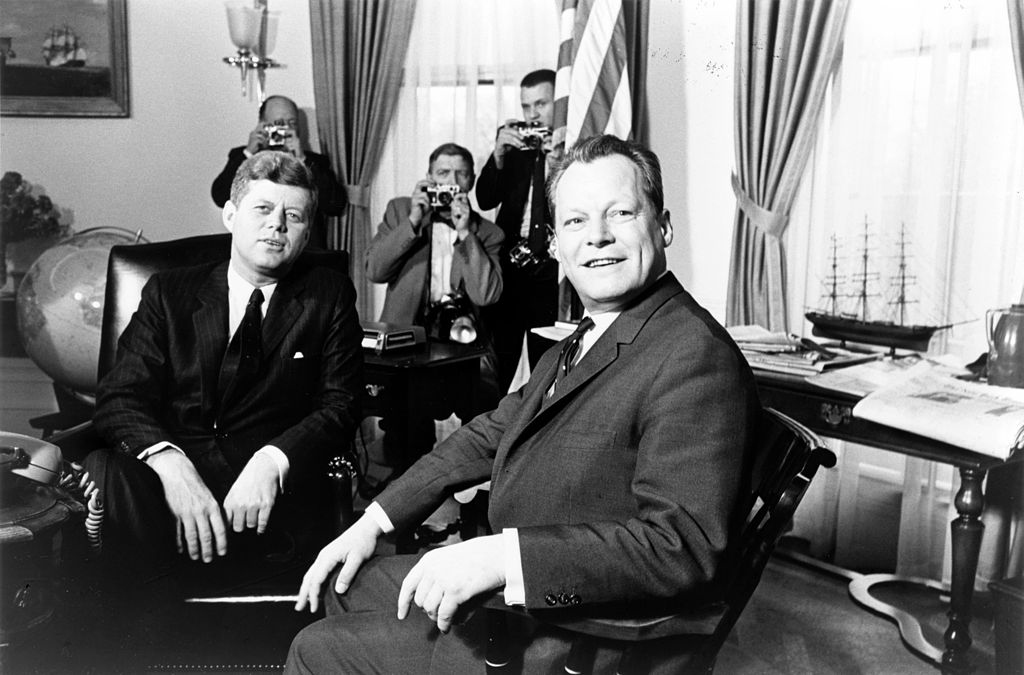
(Photo: Marion S. Trikosko, John F. Kennedy meeting with Willy Brandt, March 13, 1961, cropped 3:2, CC0 1.0)
So now you can learn in a vivid state-of-the-art exhibition about Brandt’s extremely diverse and exciting life in connection with many key historical events.
The interactive ticket takes you on a fascinating journey through history.

In 1971, Willy Brand got the Nobel Peace Prize and is one of three famous Lubeck-based laureates.
Willy-Brandt-Haus Lübeck
Königstraße 21
23552 Lubeck
Phone: + 49 – 451 – 12 24 25 – 0
The exhibition is open daily from 11 a. m. to 6 p. m. except for about six days per year that you can check out on their website.
Buddenbrookhaus
The first Nobel Prize laureate from Lubeck was, of course, the famous writer Thomas Mann. He received it in 1929 for his novel Die Buddenbrooks.

Only, the Lubeckers were not as happy as you might expect – understandable since many of them identified themselves and their neighbors in the quirky characters Mann is depicting in this book.
However, today the so-called Buddenbrookhaus is one of Lubeck’s most visited museums. It houses the Heinrich und Thomas Mann Center and a complete exhibition on the Mann-family – I cannot think of one of the Manns who was not a writer, be it the brothers Heinrich and Thomas or one of Thomas Mann’s six children.
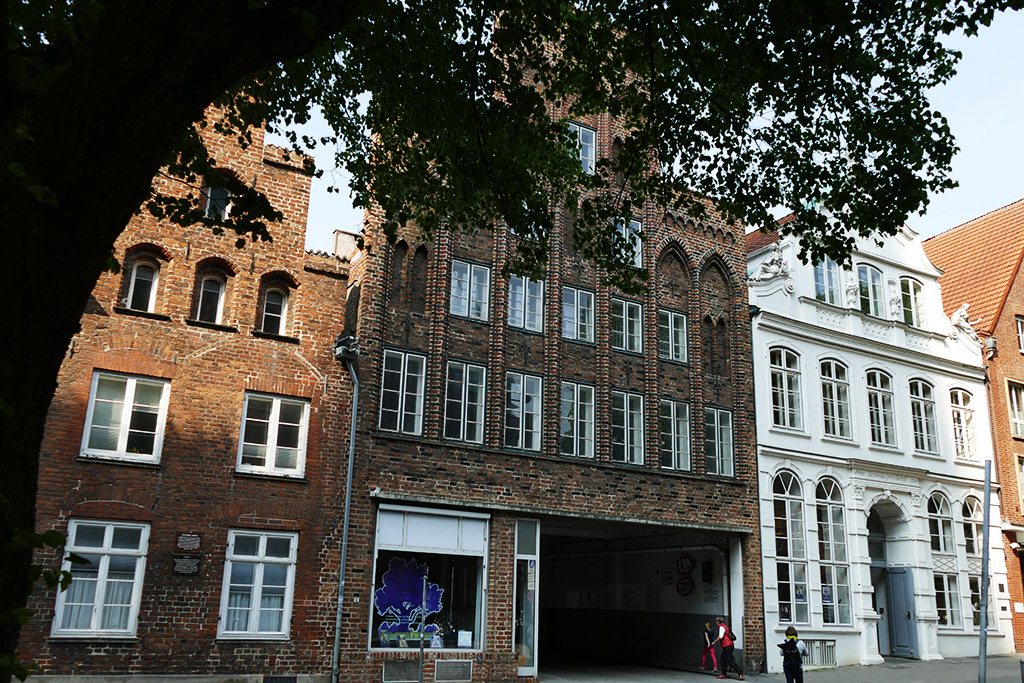
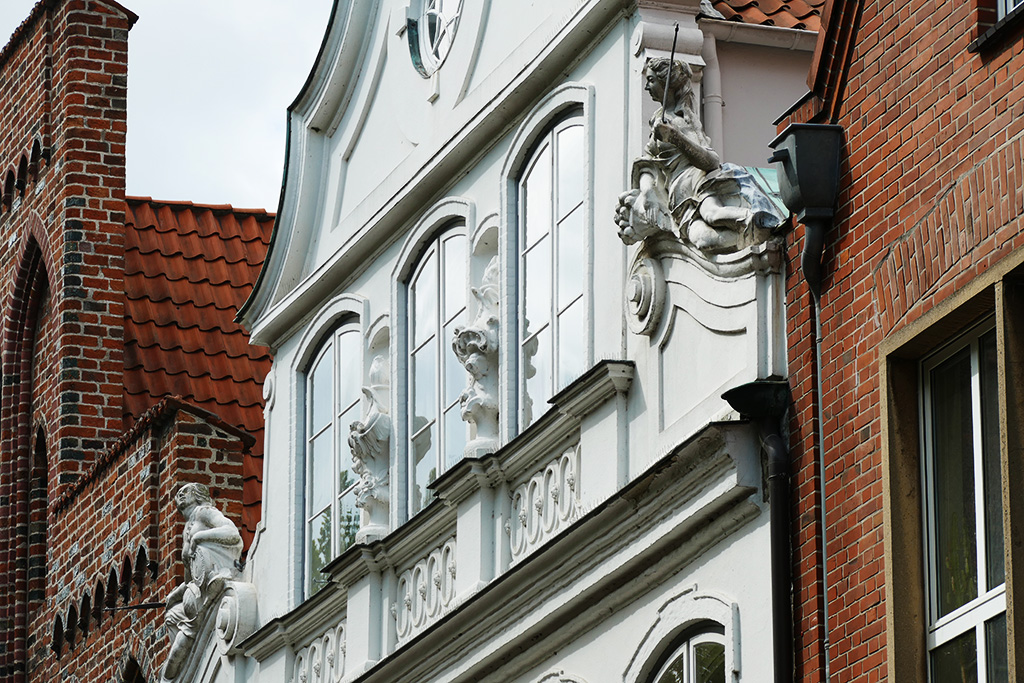
In 1842, Mann’s grandfather, of course, a wealthy merchant, purchased this building and henceforth, it was the family’s home. However, the brothers Mann spent only their youth here. During the Nazi-era, they had to flee Germany and lived first in Switzerland and later in Pacific Palisades in the United States. As Thomas Mann returned to Europe after the war, he made Switzerland his home where he died in 1955.
Buddenbrookhaus
All this and much more is documented at what today is called the Buddenbrookhaus.
The house was built in 1758. Two figurines are adorning the white facade below the gable: The left one symbolizes time, the right one prosperity.
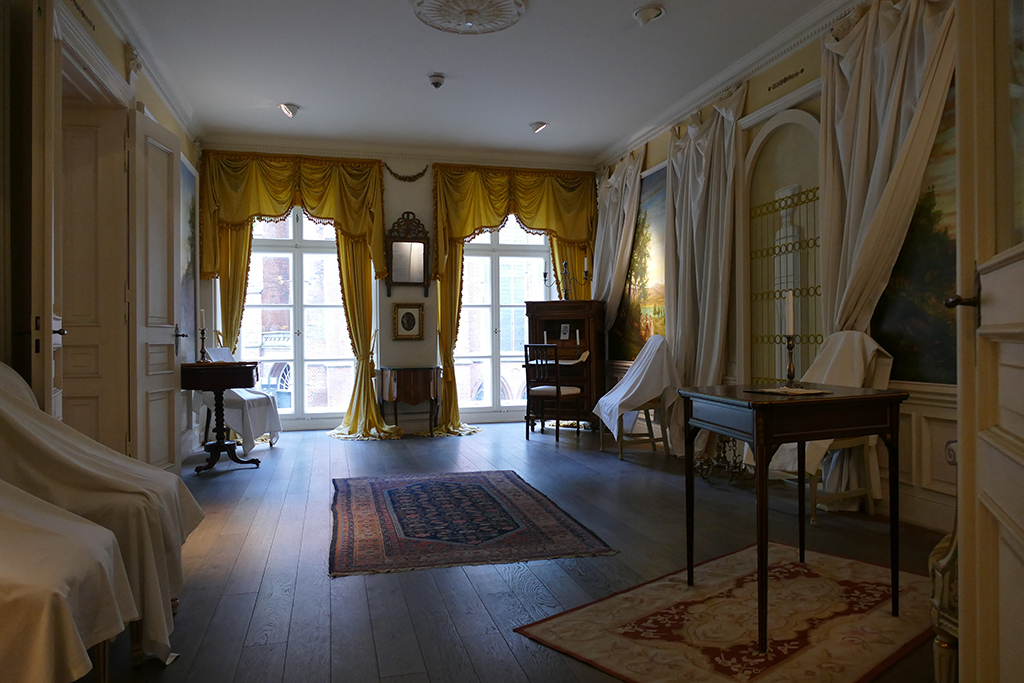
In the early 19th century, also this house was renovated and decorated by the renowned Danish architect Joseph Christian Lillie. Lillie, a representative of the Copenhagen Classicism, transformed a number of houses of Lubeck’s high society – like e. g. the Behnhaus, as mentioned above.
Buddenbrookhaus – Heinrich-und-Thomas-Mann-Zentrum
Mengstraße 4
23552 Lubeck
Phone:+ 49 – 451 – 122 41 90
Email: buchungen@buddenbrookhaus.de
The museum is open daily from 11 a. m. to 5 p. m.
Günter-Grass-Haus
The third of Lubeck’s Nobel Prize winners was born in 1927 in Gdansk – Danzig in German – and later chose to live and work in Lubeck’s outskirts. It’s writer, graphic artist, painter, and sculptor Günter Grass who received the Nobel Prize in Literature in 1999.

The Günter Grass House was opened as a forum for literature and fine art in 2002 in the Glockengießerstraße, one of Lubeck’s most intriguing streets where many of the famous courtyards are located – I’ll get to them in the next section.
The focus of the museum is the dialogue and interaction between literature and fine art in Grass’ work.
When visiting, don’t miss the ingenious sculptures in the backyard.
Günter Grass-Haus
Glockengießerstraße 21
23552 Lubeck
Phone: + 49 – 451 -122 42 30
Post War till Today
Today, as you see all these majestic buildings, the churches, the cute alleys, and courtyards, it’s hard to imagine, that across the old town island, a 300-meter-wide swath from the Cathedral all the way to St. Mary’s Church was more or less completely destroyed.
Also, the area north of the Aegidien Church and large parts of the suburb west of the Holstentor and the main station were hit during the air raid on Lubeck on March 29, 1942. It was the first surface bombing of a German city center by the RAF Bomber Command in WWII.
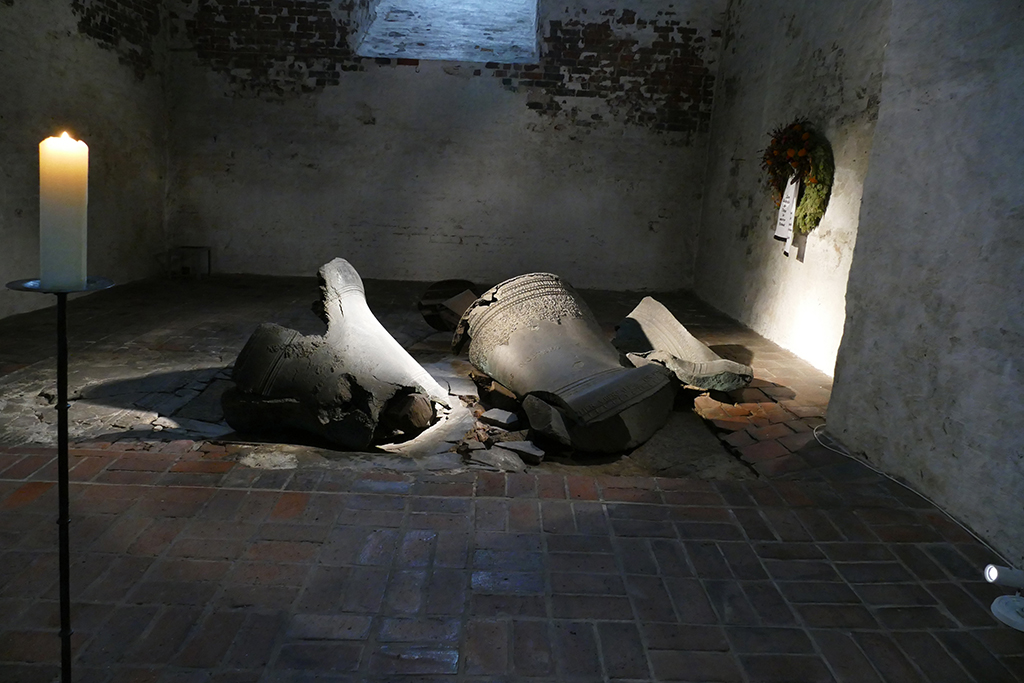
Being such an important target shows, that at that time, Lubeck still was considered an economic and industrial power due to its proximity to the north sea and the Baltic.

According to the police, 783 people were injured and 320 lost their lives. Also, over 15,000 Lubeckers lost there homes as 1,468 buildings were completely destroyed and around 12,000 were damaged. There are memorials all over the city, the most impressive at the Cathedral and St. Mary’s Church.
Risen From the Ashes
Today, Lubeck has about 220,000 inhabitants and is Schleswig-Holstein’s second-largest city after the federal capital Kiel.
Besides other industries, tourism is a big factor in Lubeck – not only on a national, but also on an international level. Also, there are many day trippers from cruise ships that call at the port of Travemünde, located about 20 minutes away on the Baltic shore.
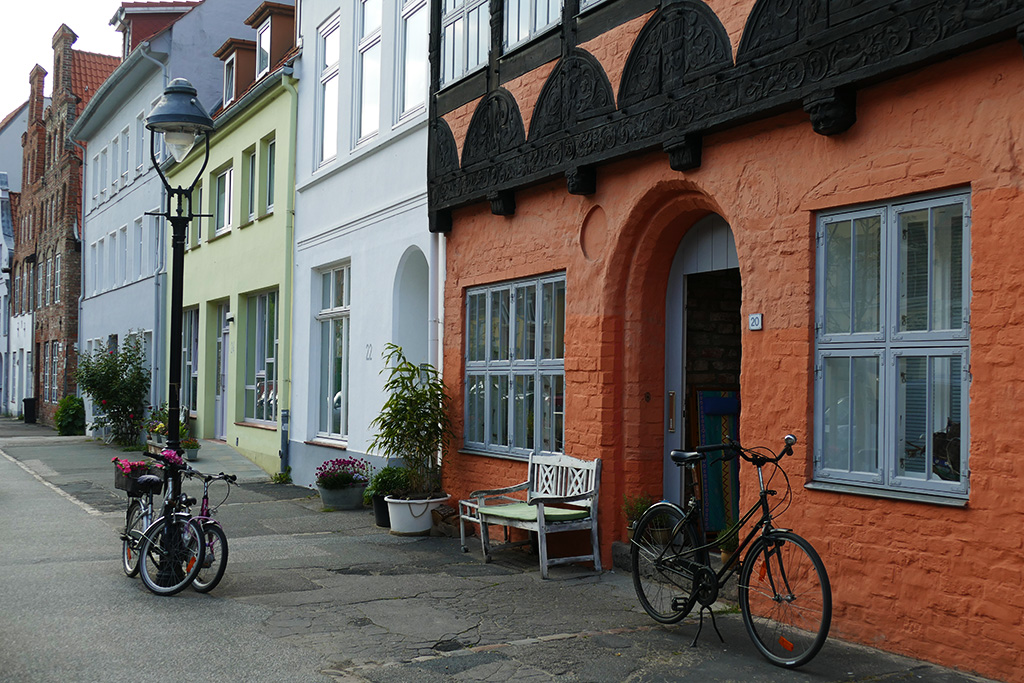
Visiting the marvelous city of Lubeck, don’t stick only to the majestic buildings I’m introducing in this post. Make sure to venture crisscross the city center. This way, you will enjoy the sight of numberless cute corners, courts, and alleys.
Lubeck’s Courtyards
Lubeck is well-known for these corridors and courtyards. They are residential quarters. Initially, they were constructed from the lack of space in the backyards of the residential buildings and rather for the poorest city dwellers. However, today, they are sought after living space.
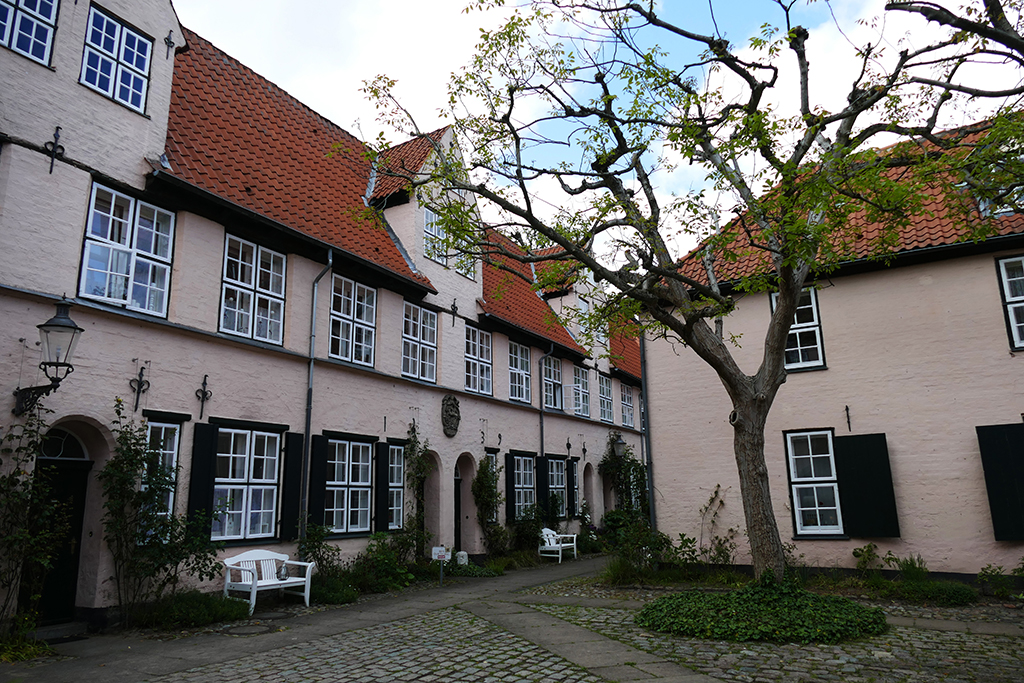
The largest and most beautiful courts are certainly the Füchtingshof and the Glandorpshof in the Glockengießerstraße – close to the Günter Grass Haus that I’ve introduced above.
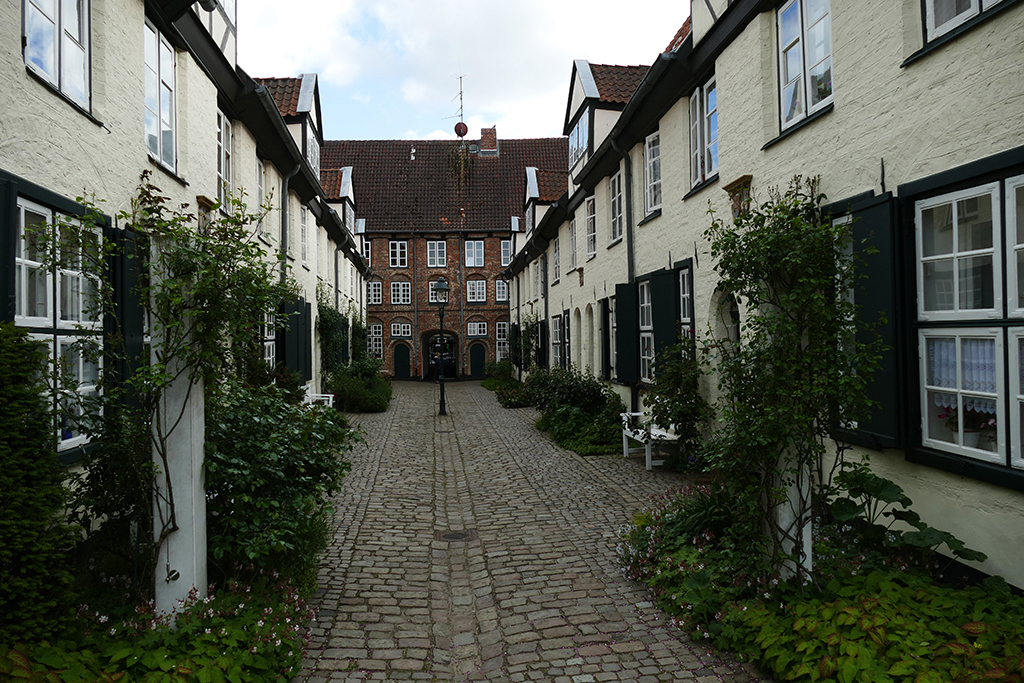

There are over 100 such aisles in Lubeck’s old town. Some of the city’s many foundations financed the renovation of many of these passages and courtyards. This, by the way, is the reason why people like you and me can just enter and look around and even take pictures. Of course, these little jewels add to Lubeck’s charm and thusly tourism.

However, you should not invade people’s privacy and keep out from about 6 or 7 p. m.

Practical Information
Getting There…
First, I’d like to apologize to my regular readers, you can probably sing about the Ländertickets, the federal state tickets, supplied by the Deutsche Bahn, Germany’s national train company.
Nonetheless, here it comes again:
The Deutsche Bahn offers the so-called Ländertickets, country tickets that are valid for one day in a specific federal state.
Every federal state has its own and the cost varies from about 24 to 29 €uro.
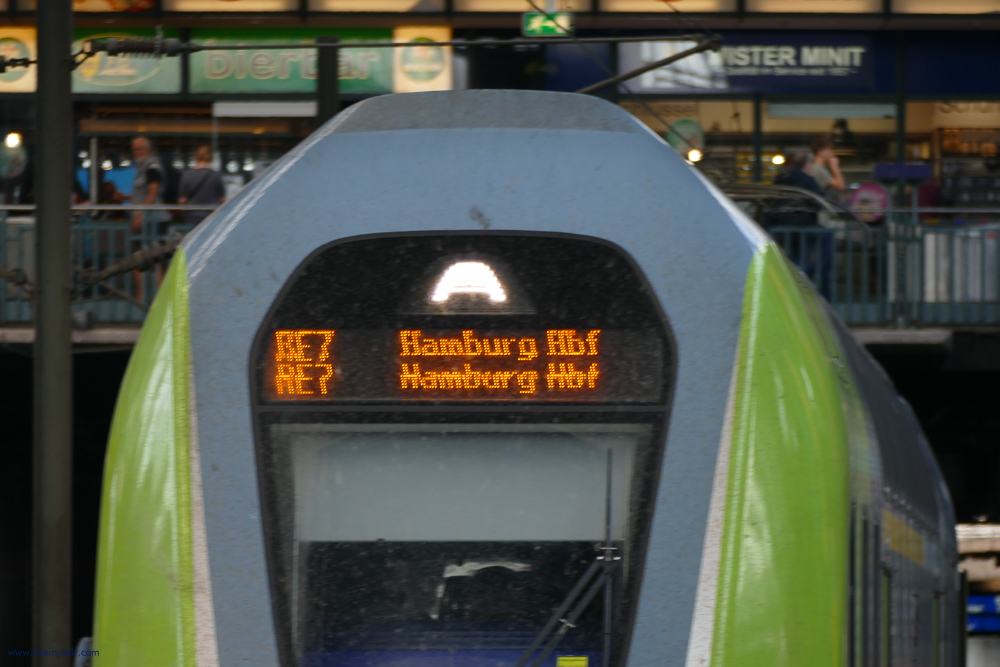
Travelling Through the Federal Country of Schleswig-Holstein
Lubeck is located in the federal state of Schleswig-Holstein, and the Schleswig-Holstein-Ticket costs 28 €uro for one and you have to add another 4 €uro per person travelling with you. So if you are two adults, it will set you back 32 €uro for both of you, if you travel with four other people, you’ll pay 44 €uro for your party of five; not bad, right?!
A child under 15 travels for free with two adults.
While you can actually travel the entire day within the respective federal state, you are only allowed to take the regional trains. Those train numbers begin with RE, MET, etc. However, you cannot take interregional trains such as the Intercity (IC) or Intercity Express (ICE).
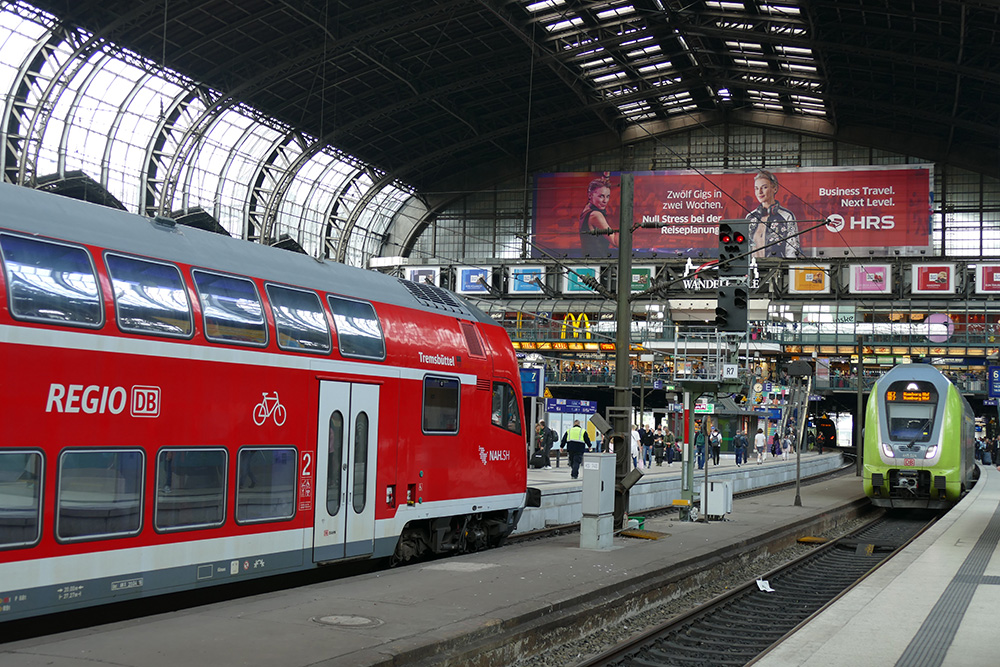
Extra: The Schleswig-Holstein-Ticket covers also the federal state of Mecklenburg-Western Pomerania as well as the city-state of Hamburg.
However, if you are travelling by yourself, a one-way ticket to Lubeck will be cheaper than the Schleswig-Holstein-Ticket. Therefore and for other connections and rates, please visit the Deutsche Bahn’s website, it’s available in seven languages.
Roads and Traffic
Of course, you can also drive to Lubeck, but keep in mind that major parts of the inner city you want to visit are either really narrow or pedestrian areas. There are parking lots close to the Holsten gate, I’ll mark them on the map below.
Also, bus companies like the internationally operating FlixBus cater to Lubeck, and the bus stop is right next to the train station.
…and Around
Not only are parts of the inner city pedestrian areas. Many streets and alleys are also pretty narrow and parking space is limited and expensive.

So if you are coming by car, the best way is to leave it at one of the spacious parking lots north of the Holstentor and explore the city walking. This is the best way to enjoy the superb architecture with all the charming details, anyway.
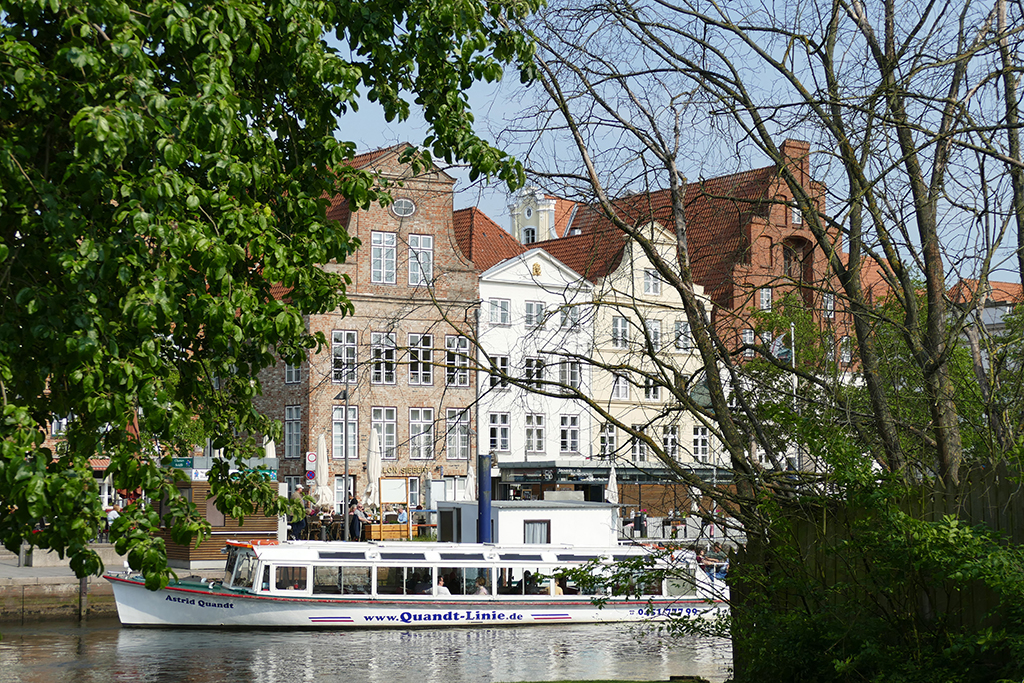
Of course, there are also public buses, but I really think you should rather prepare for lots of walking. And it will mostly be on cobblestone so don’t even think about wearing heels or other foolish footwear.
Best Place to Sleep
Obviously, you cannot stay either at the town hall or at St. Mary’s Church, but location-wise, the Motel One is really the next best thing: It is located just a stone’s throw from either of these landmarks and if you are lucky, you’ll have a view on them from your room; I had a partial view which was very enjoyable.
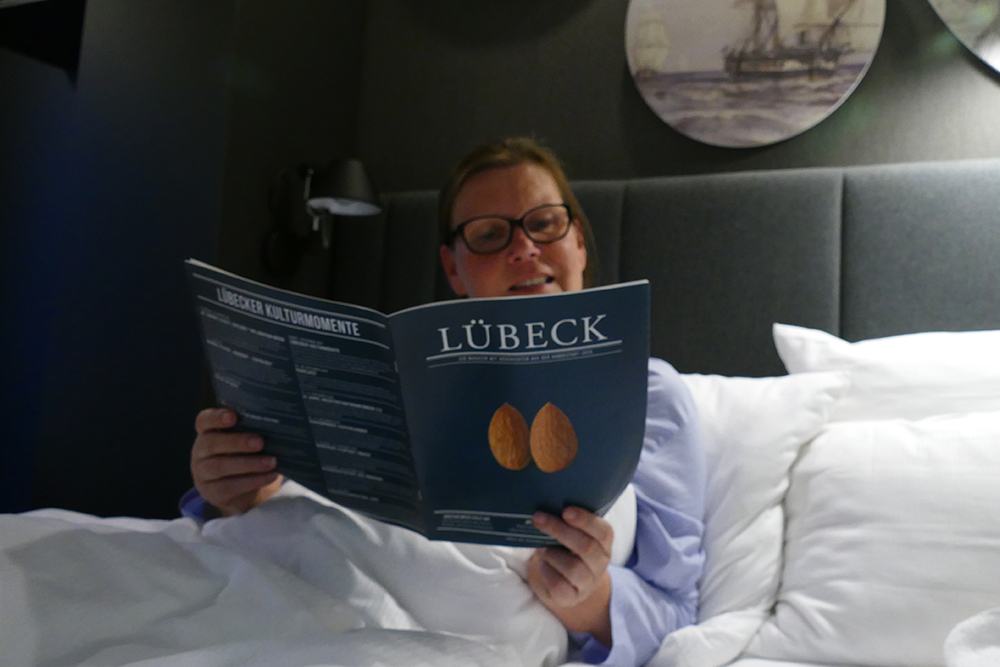
The Motel One hotel chain is getting very popular for a reason: You’ll get a really comfy room with everything you might need during a city break.

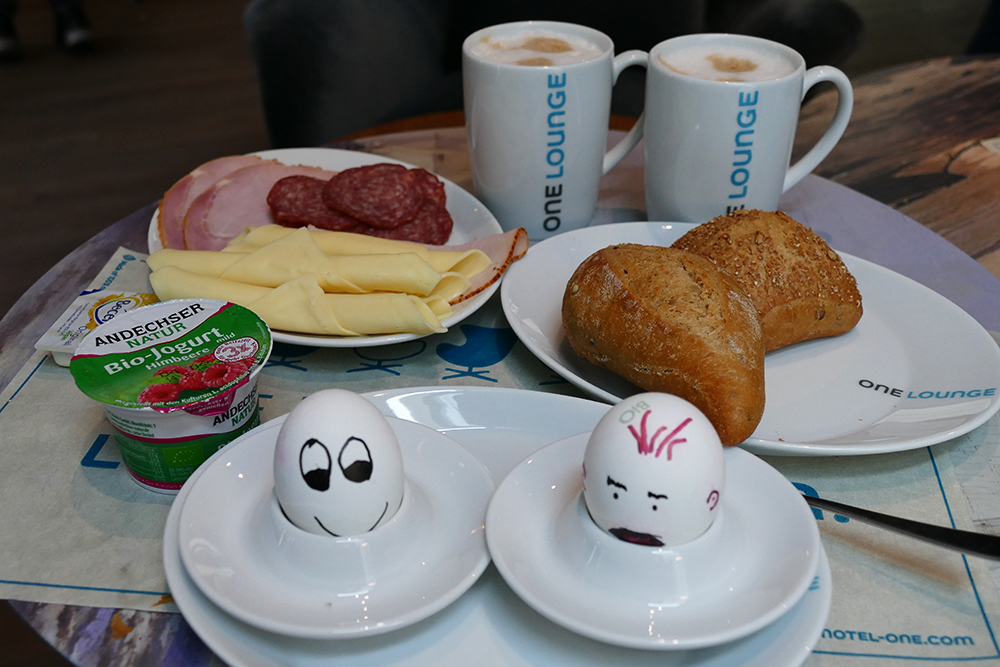
At Motel One, they give all eggs an individual look – I think this is just so cute.
Breakfast is not overwhelming quantity-wise, but I appreciate very much that everything is organic and, in any case, you won’t leave the breakfast table hungry. Talking ’bout breakfast table: I really enjoy their approach to design. At breakfast, you are sitting at a long table decorated with stylish vases under paper lampshades, designed in an antique maritime fashion. And all this at a really reasonable price.

Following this link, you can check Motel One’s availability and rate*.
In case they are booked out, you can conveniently search for other great lodging options on this map*:
Booking.comBest Place to Eat
Of course, there are many restaurants in Lubeck. Whether you are going for traditional North German cuisine or dishes prepared by the many immigrants like Turkish kebab or Asian food.

I’m actually introducing the two most important Cockaignes. When in Lubeck, you shouldn’t miss out on the Schiffergesellschaft and the Café Niederegger. I’m introducing the first one in the medieval chapter above and the latter in the shopping chapter below.
What to See
I’m an avid solo-travelling woman. Since solo travel doesn’t equal solitude, I love to join organized tours here and there. They allow me to meet fellow travellers – for just a short moment or a lifelong friendship.
Especially if you have only a short time for exploring the city of Lubeck, an organized trip will enable you to make the best of it*:
Best Place to Shop
Cosmetics
Wanna see as much as possible of the stunning architecture and learn about the fantastic history – but also eager to shop around? Amazingly, in Lubeck, you can do both at the time: Some of the most important landmarks are great for doing your souvenir shopping, too!
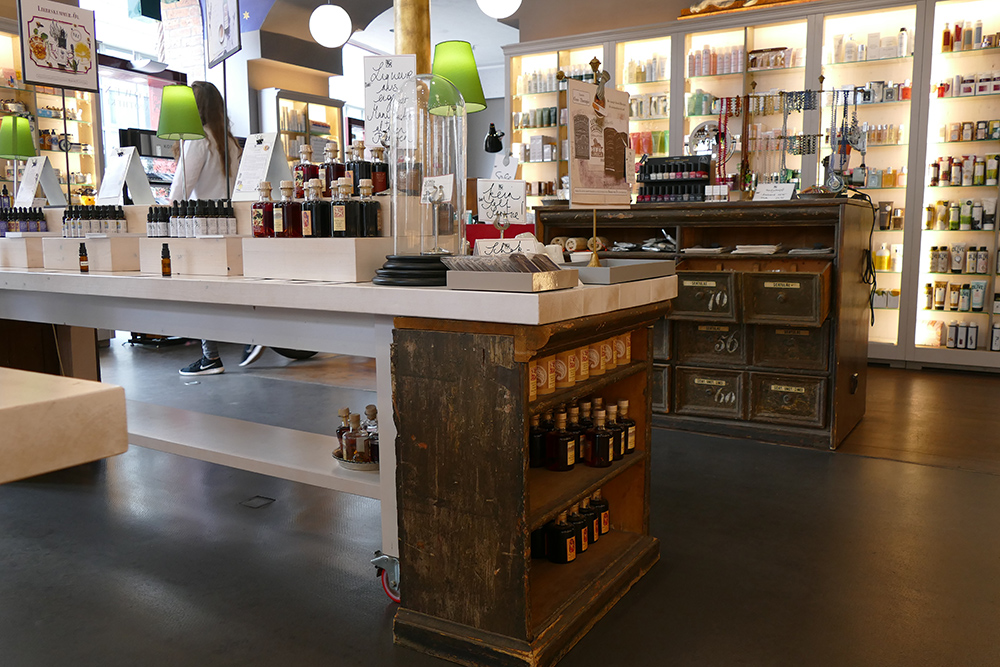
The Löwenapotheke, the Lion’s Pharmacy, is housed in Lubeck’s oldest building. Built around 1230, it was just another posh family home until in 1375, Emperor Charles IV paid Lubeck a visit – in the company of numerous entourage and Empress Elisabeth in tow.
She was accommodated in this house while Charlie stayed across the street. A wooden bridge was built so the two love birds could pay each other unobserved visits.

The house has been a pharmacy since 1812 and their handmade cosmetics and health care products make great gifts – to your body and those of your loved ones at home.
Löwen-Apotheke
Dr.-Julius-Leber-Straße 13
23552 Lubeck
Phone:+ 49 – 451 – 75 47 0
Email: shop@loewen-apotheke-luebeck.de
The pharmacy is open on weekdays from 8 a. m. to 6:30 p. m. and Saturdays from 9:30 a. m. to 3 p. m.
Marzipan
A souvenir everyone will enjoy is real Lubecker Marzipan, marzipan from Lubeck, manufactured by J. G. Niederegger and brought in the cutest shapes since 1806. Even if you don’t like to eat it, you’ll love to look at the fruits, vegetables, fish, and teddy bears made from this sweet almond mixture.
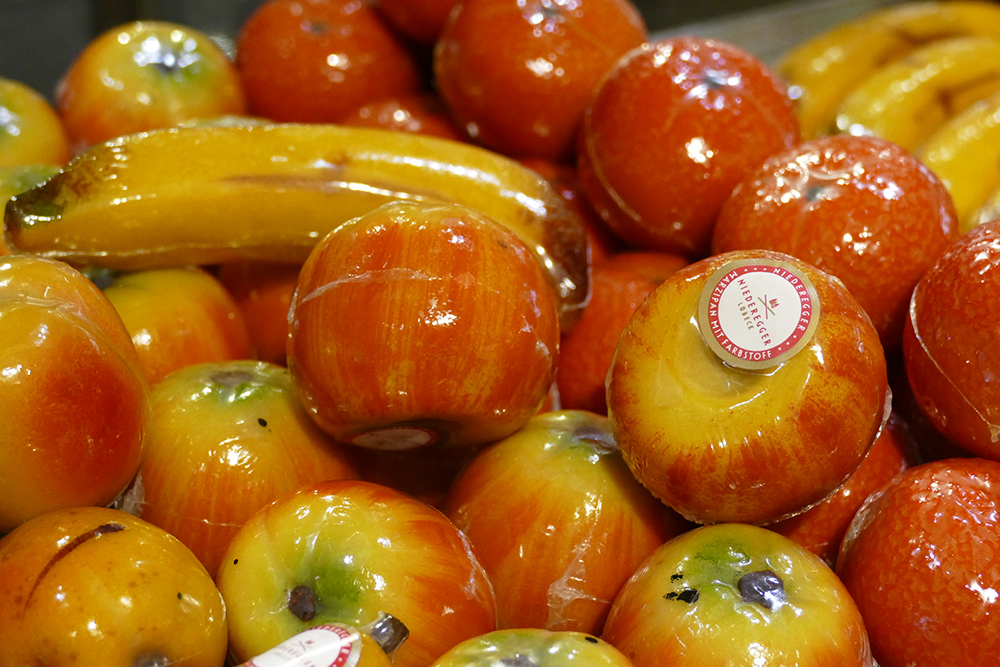
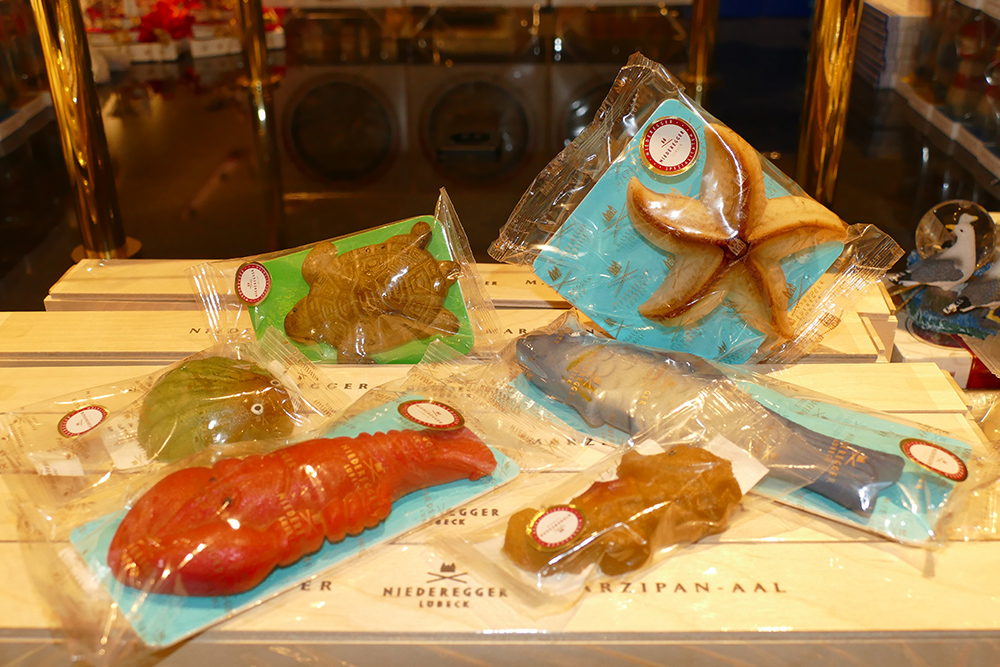
Niederegger produces 30,000 kilograms of marzipan daily – right here in Lubeck, otherwise, it wouldn’t be the real deal. Besides their signature product, they also have nougat, pralines, truffle, and cookies in store. Oh, not only in store, but also at their elegant café on the second floor where you can enjoy their famous nut cake, covered with a layer of marzipan.
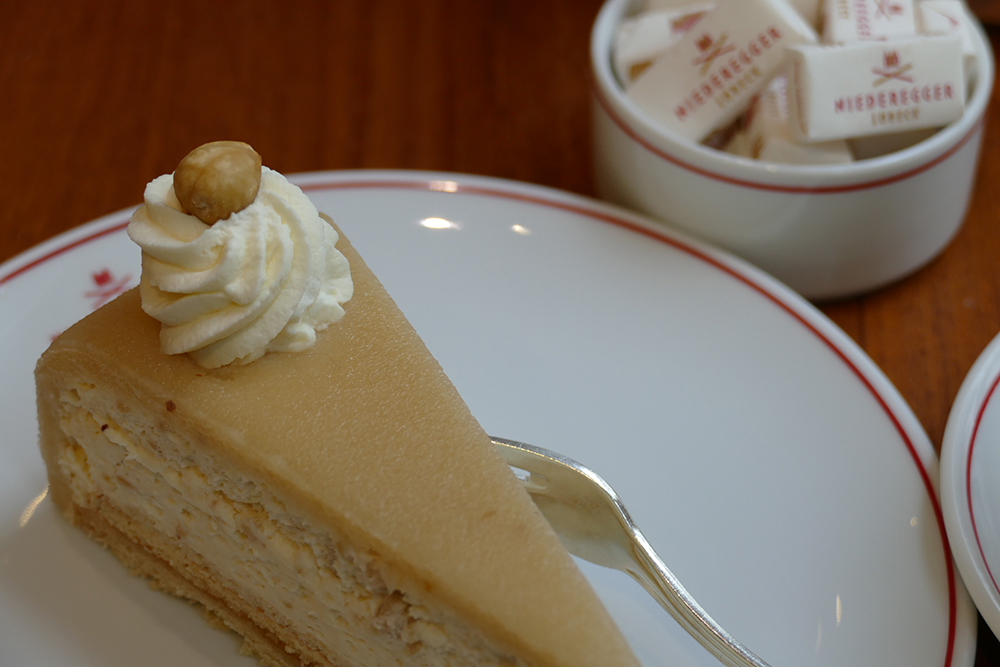
On the third floor, by the way, is a small museum where you can admire i. a. a group of twelve life-size statues depicting famous German men – yes, only men, it’s a scandal! The entrance is free, though.
Niederegger
Breite Str. 89
23552 Lubeck
Phone: + 49 – 451 – 530 11 27
Opening hours are weekdays from 9 to 7, Saturdays from 9 to 6, and Sundays from 10 to 6
Books and Stationery
A wonderful souvenir from Lubeck should be, of course, Thomas Mann-related.
The Buddenbrookhaus has a lovely gift shop where you find each and every book this literally genius ever wrote – and, obviously, also books by his brother Heinrich, his son Klaus, and more.
Don’t speak any German? They have some of the books also in English.
Don’t speak any English? How are you reading this blog then?
Just kidding!
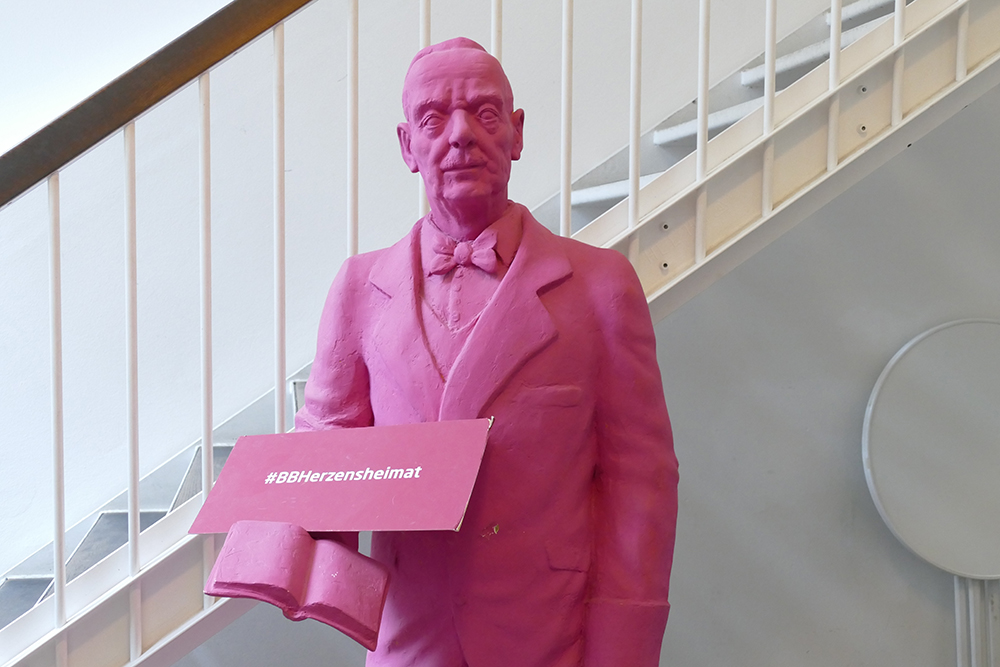
Besides various editions of his books and movies based upon them, they have also a variety of decoration and stationery on sale at the Buddenbrook Haus’ giftshop.
If you don’t want to purchase a book but still want a Mann-ish souvenir, they have lots of nice stationery like pens, notebooks, postcards, posters, and more in store; you’ll find something you like, I’m sure of that.
Buddenbrookhaus – Heinrich-und-Thomas-Mann-Zentrum
Mengstraße 4
23552 Lubeck
Phone:+ 49 – 451 – 122 41 90
Email: buchungen@buddenbrookhaus.de
The museum, as well as the gift shop, are open daily from 11 a. m. to 5 p. m.
Money
Since Lubeck is pretty touristy, credit cards are widely accepted, however, there are also ATMs all over the place.
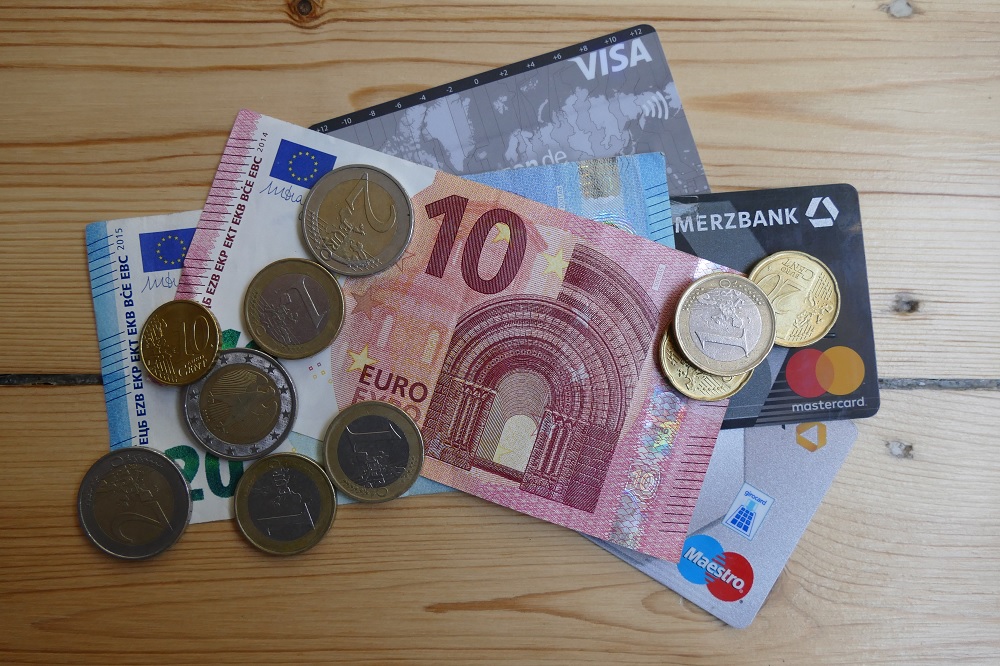
The exchange rate is 1 US$ = 1 €UR as of November 2022, but you can check the conversion on this page.
Language
Most people in Germany have at least a rudimentary knowledge of the English language, many even speak it pretty decently. Lubeck gets quite a lot of international visitors, so at least with English, communication should be no problem at all.
However, for some useful words and phrases, you might want to practice a little with help from e. g. Babbel (the first lesson is for free and already supplies you with useful basic vocabulary).
*Note: In this article, I’m writing out some of the German names and places and you will notice that there are letters that might not exist in other languages. Most importantly for this article, there is the letter ü being pronounced more or less like the u in huge. Then there are also the vowels ä, which is very easy since it’s pronounced like an open e as in head, and ö that is pronounced approximately like the e in her. The letter ß, which exists only in the German alphabet, is by no means a B – it’s a ‘sharp’, double S as in kiss. When writing, you can actually replace it by a double S.
Tourist Info
After having read this post down to here, do you still need further information or have specific questions? Of course, I’m here for you, but more importantly, so are the friendly and knowledgeable people at the
Lübeck und Travemünde Marketing GmbH
Holstentorplatz 1
23552 Lubeck
Phone: +49 – 451 – 88 99 700
Map
This map should help you to find all the wonderful places that I’m introducing in this post.
Pinnable Pictures
If you choose to pin this post for later, please use one of these pictures:

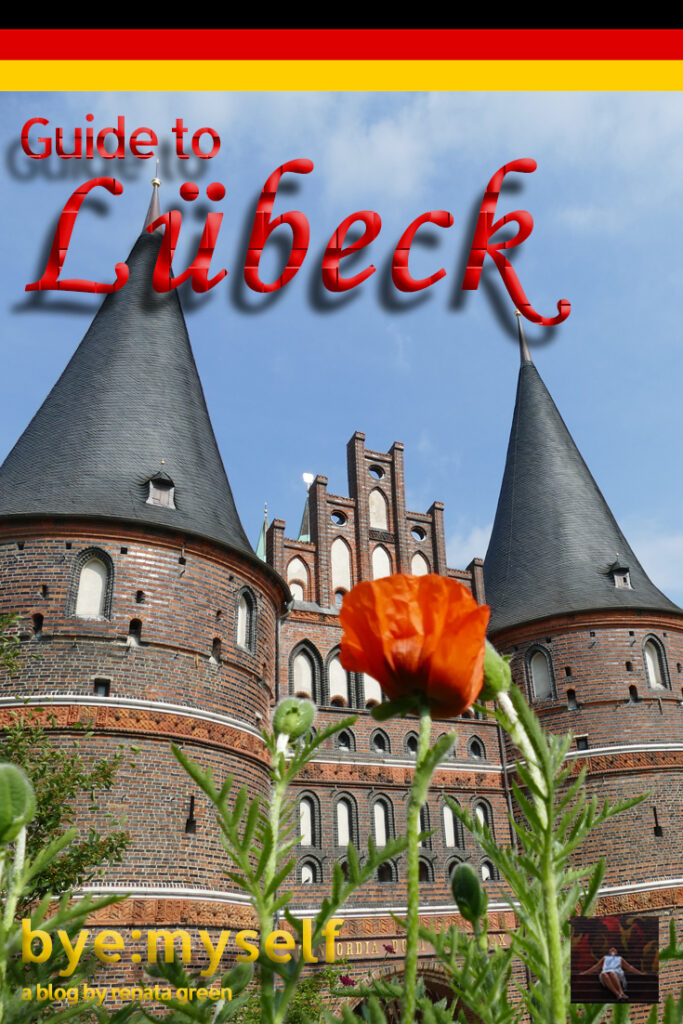

Note: I’m completing, editing, and updating this post regularly – last in November 2022.
Did You Enjoy This Post? Then You Might Like Also These:
24 hours in FRANKFURT
The Island of NEUWERK – where the way is the goal
Guide to POTSDAM – how Frederick made a small town great
The Island of HELIGOLAND – soft spot with rough edges
24 hours in DUSSELDORF
How to Visit the NordArt in 2022
NordArt 2024: Everything You Need to Know Before Your Visit
Guide to DUSSELDORF, the Self-Proclaimed Longest Bar in the World
Disclaimer: I appreciate that Lubeck und Travemünde Marketing GmbH arranged free entrance to the city’s museums and landmarks, offered me a city tour, supplied me with vouchers to sample some delicacies at Niederegger and the Schiffergesellschaft and booked me into the MotelOne hotel. However, all opinions on these services are mine. They were in no way influenced by my cooperation partner.
* This is an affiliate link. If you book through this page, not only do you get the best deal. Also, I get a small commission that helps me run this blog. Thank you so much for supporting me!

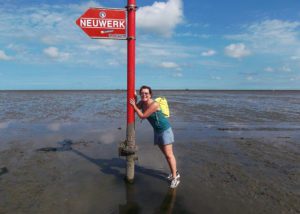
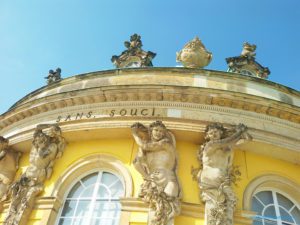




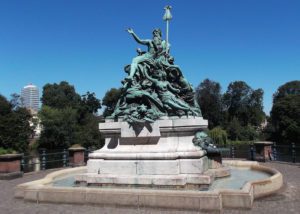
This post is certainly worth reading before viting Lubeck. Thanks for those tons of great tips on what to see when visiting the city.
I am totally blown away by your extremely comprehensive information for Lubeck. Wow and thank you! Living part-time in Hamburg, Lubeck has always been a frequented city for us. Because of your excellent article, I realize how much I have yet to explore. We head over there on Wednesday with notes from your post. One draw for us over there has always been lunching at the restaurant Ratskeller zu Lübeck.
Be well.
I’m so happy for you! And so glad you like my post. Lübeck is my favorite German city. However, I’ve never been to the Ratskeller, I only know the Schiffergesellschaft – where it’s good, but mostly about the decor, obviously.
Have another fantastic trip to Lübeck!
I never about Lubeck before reading your post and it is truly ravishing. The city hall square from top of tower looks stunning. I loved this city’s medieval architecture.
Lubeck is gorgeous! It’s easy to see how it reminds you of Venice. I’d love to visit some day and experience it in person.
You should – I’m sure you’ll love it!
This is a fantastic and in-depth article! There sure are a tonne of churches in Lubeck! lol. The architecture of all of them is beautiful. Reading about St. Mary’s and seeing the remnants of the shattered bell gave me goose bumps and had me envisioning what it was like for them during the bombing of WWII. Such a sad time in history.
Yes, the memorial – in this indirect lighting – is pretty intense; and a reminder of how precious it is to live in peaceful times in a peaceful region.
Lubeck is so impressive! I would say it is both Pisa (because of the leaning towers of Hosten Gate) and Venice combined plus the extra of the seven spires and all the other details. I was waiting to see all seven in a skyline pic, however.
You’re so right with the leaning buildings – Pisa it is 😀 Glad you liked my introduction 🙂
Wow! Lubeck is beautiful, charming, historical and cultural all at the same time. I had not thought of including it in my list of places to visit in Germany but now looks like I will have to revisit my list. And add it. Thanks for the comprehensive information collected here, I need to again come back and make notes when I get into my detailed planning on visiting Lubeck
It’s absolutely fascinating – and the famous marzipan makes also a great souvenir…not only on your hips 😉 Also – I just mentioned that briefly – you can go by public bus to the beach at Travemünde in only 20 minutes; that’s a huge perk not only in Summer.
I love this post so much. It is so cool that the old town is on an island! And Hosten Gate looks incredible. Thanks for adding another city to my list for my next visit to Germany!
Yap, if you have the chance to visit – go! It’s a dreamy place 🙂
Hi there,
please don’t forget Travemünde. I belongs to Lübeck and is always worth a trip.
You’re absolutely right – and I actually did mention it being about 20 minutes away. However, thanx, improvement is always appreciated 😉
Thanks for the information. Keep up the good work!
We have never been to Germany. But the history of this country fascinates the whole world. Lubeck seems to a wonderful place with a lot of history and a lot of activities to pursue. You have put together quite an exhaustive guide. Love the pictures too.
Thank you, I’m very glad you like it. You can see from my guide that one day in Lübeck is not enough 😉
Indeed Lubeck is fascinating. That Holsten Gate must be seen in person. Perhaps a drone can capture the Seven Spires.
Lubeck seems more charming than Venice. Walking by those lifelike figures in that dimly light hallway would be unnerving. Motel One sounds like a fun place to stay.
Love the stories about Saint Mary's Church, especially the one about little Rosemary. How on earth did you find so much information about Lubeck? Must have taken a lot of leg work! I think this post should be published as an EBook too, because it's such an excellent guide.
Ooh the epochal Holsten gate looks like something out of a fairy tail, I'll shamefully admit I hadn't previously heard of Lübeck but it looks great
Lubeck has so much rich history and has such a status for the things they have accomplished over time! I would love to spend more time here! xo – Kam
What a great comprehensive guide to Lübeck. The old town is definitely deserving of the world heritage status – such quaint streets and architecture. The Holstentor gate is just picture perfect!
A town of three Nobel Prize winners: Thomas Mann, Willy Brandt and Günter Grass sounds interesting. And the architecture is lovely! Definitely putting Lübeck on my list of places to see in Germany.
Thanx for LÜBECK guide! Love the architecture & Thanks so much for all shots!
We only discovered Lubeck recently…planning to visit soon.
It is great to hear about a great cute town that is not suffering from over-tourism – even being a cruise excursion destination from the Baltic. Especially when it reminds you of Venice. Even if it is not because it is criss-crossed with canals. Such an interesting history for this small town. Such beautiful buildings. I love that the towers are crooked – and have been left that way. I would hope for a little luck from rubbing the horns of the devil!
…and if the devil doesn't work, there still is the mouse Rosemarie at the church.
Thank you for the detailed and rich history of Lübeck. I have to admit, until reading your post, I had never heard of the city. The old churches are magnificent and I'm glad many of them were restored. I've been to Germany before, and next time, I'll be adding Lübeck to the list.
…and you will also enjoy Lübeck's culinary side, I can promise you that!
so much history! And i love the architecture. How I wish I visited Lubeck when I traveled to Germany. thank you for sharing this detailed guide
She's been there for so long, she will wait for you to come back 😉
Such a historic place. It would be wonderful to tour this ancient city. I love all the buildings churches and history. The sores sound awe inspiring!
Yes, it's amazing how much great history they squeezed into this small city island 😀
I just spent 10 days in some Medieval villages of France and fell in love with the buildings. Luebeck looks equally as enchanting and a charming town to discover, with the added bonus of the water!
I think it will just blow your mind; and it's twenty minutes by bus from a beach on the Baltic sea….
On reading this, I simply asked myself why I have not been here yet. What an absolutely gorgeous place. And definitely close enough to qualify for an unplanned adventure in the not too distant future. Thanks for all the comprehensive info – is it wrong that I am already coveting a visit to the pharmacy as well as all the incredible buildings?
Nope, it's not. Good planning is key….but you should still leave room for surprises and dessert 😀
Smashing read. Germany has been on the bucket list for a good long while. I will absolutely saving this for future reference. Thanks so much for all the info!
The north is pretty much underrated – but I can only recommend it since it's so, so charming.
Wow! I did Lubeck as a day trip from Hamburg but I didn't think there was THAT much to do in Lubeck and I missed out on quite a bit. I remember walking around the old town walls and the cobble streets and going to a candy store and buying lots of sweets! 😀 But this was going back to 2008 I think, so my memory isn't that great. A revisit is needed me thinks.
Actually, just strolling up and down those cute streets is one of the best things to do there, anyway 😉